THANKS TO OUR SPONSORS




March 3, 2024





Whether you realize it or not, you’ve probably had an experience with artificial intelligence — the use of technology to perform functions normally associated with the human mind.

Maybe you’ve asked Amazon’s Alexa for a weather forecast. Or perhaps you’ve simply enjoyed scrolling through viral images depicting what famous historical figures would look like if they were alive today.
It’s all made possible by artificial intelligence.
But AI’s capabilities go much deeper, and a growing number of Lancaster County businesses, organizations and individuals are discovering its potential.
In this issue of Progress, we take a look at some of the challenges and benefits of AI as we explore how it’s currently in use in Lancaster County — from the arts and the classroom to home design and health care — and where it could be headed in the future.
2 • MARCH 3, 2024 CONTENTS COMMUNITY 13 ECONOMY 3 EDUCATION 7 ENVIRONMENT 37 HEALTH 23 HOME 29 Content Editor: Margaret Gates Cover Artist: Angel Luciano Visual Editor: Abby Rhoad Managing Editor of Content: Stephanie Zeigler Team Leaders: Pat Bywater, Jenelle Janci To receive information on advertising, call 717-291-8800.
ECONOMY

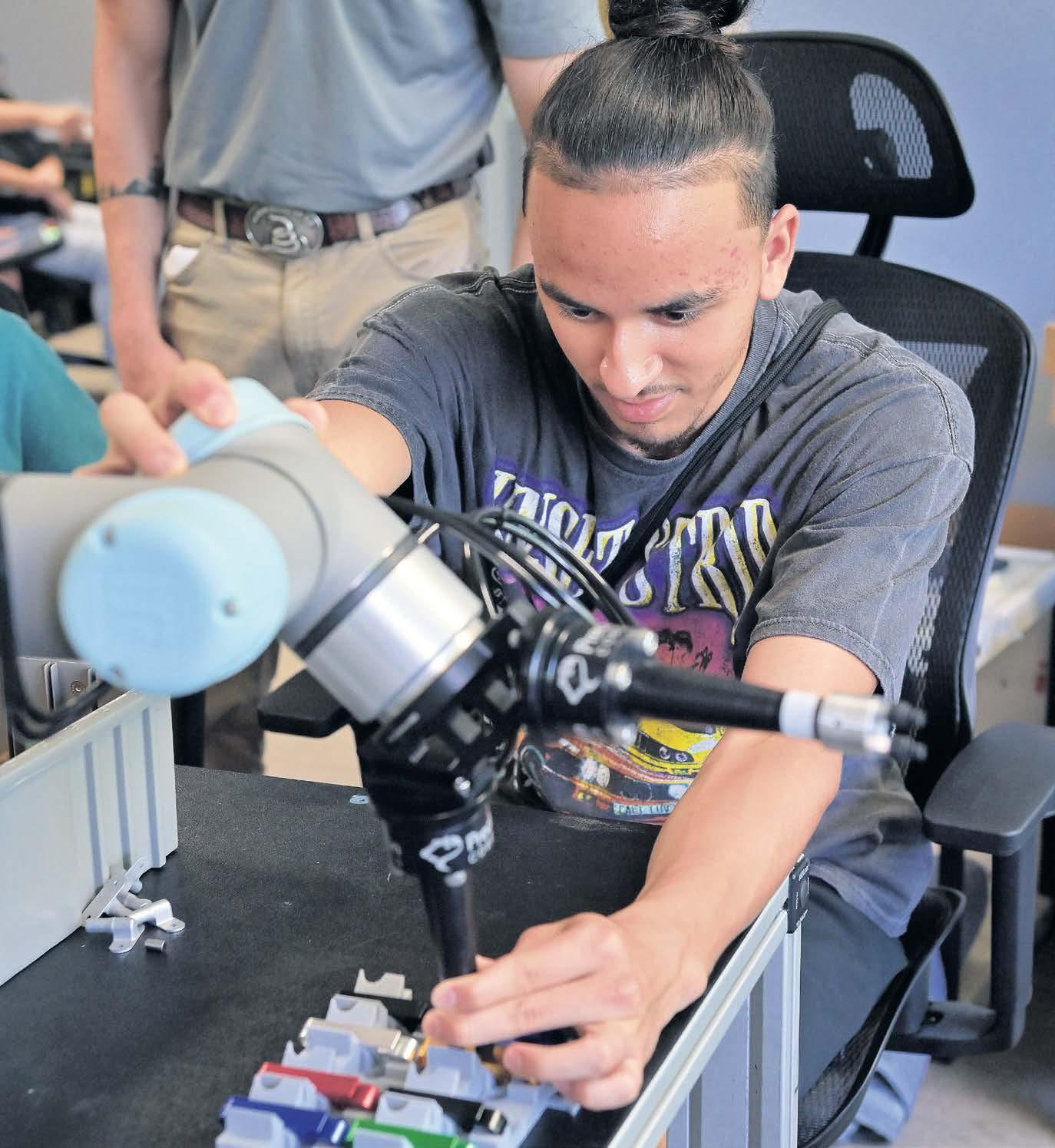

MARCH 3, 2024 • 3 PROGRESS LANCASTER COUNTY
Aiden Burgess maneuvers a robot during a summer robotics camp at Precision Cobotics.
PAGE 4 SUZETTE WENGER | STAFF PHOTOGRAPHER
The Lititz-based firm uses AI in the manufacturing sector to help material-handling robotic arms adapt to unexpected situations.
AREA MANUFACTURERS SLOWER TO JUMP ON THE AI BANDWAGON
REBECCA LOGAN FOR LNP | LANCASTERONLINE
Don Bolton is up against some headwinds when it comes to spreading the word about what he thinks artificial intelligence can do for manufacturers.
He used to be a design and process engineer, serving companies like General Motors, Chrysler, Kuka and Comau. He sees the reports, like one released in December by MarketsandMarkets that predicts the value of Automotive AI will grow from around $2.2 billion today to $7 billion by 2027. But Bolton left automotive-fueled Michigan about four years ago to move to Pennsylvania and become a business adviser for Mantec — a not-for-profit industrial resource center serving nine counties including Lancaster.
“When I took this job, I had an extremely high expectation because of the work I’d done back in Michigan. But it’s not the same here,” he says. “People see the price tag and they’re like, ‘Maybe I can’t justify that.’ ”
Bolton created what he considers a handy return-on-investment tool to make his case. It’s only going so far. He’s helped some clients throughout Mantec’s coverage area install AI offerings. But he’s hoping to do a lot more.
“Pennsylvania — especially this area — is slightly behind implementation of automation, AI, industry 4.0 in general,” he says.
Nationally and internationally, implementation is coming fast and furious. In January, Forbes magazine ran a piece by Dr. Ayesha Khanna, CEO of Singapore-based AI consulting firm Addo, titled “How AI is reshaping five manufacturing industries.”
She picked automotive, electronics, aerospace and defense, food and
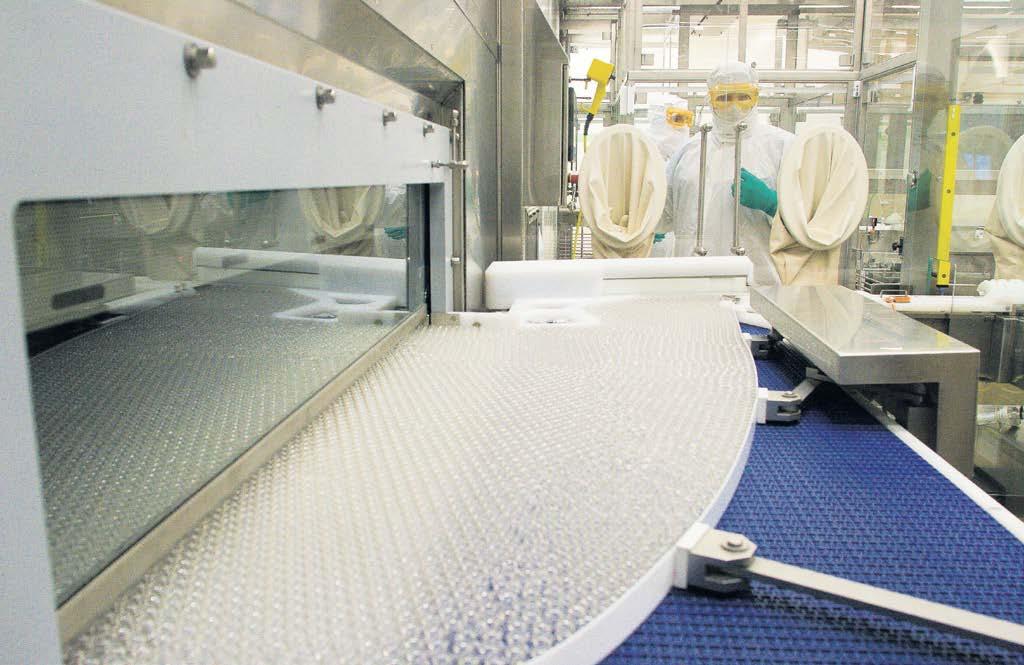
beverage, and pharmaceuticals. Describing the latter, Khanna notes that Pfizer used IBM’s supercomputing and AI to design the COVID-19 drug Paxlovid in four months — 80% to 90% faster than a typical timeline.
Such acceleration has the potential to greatly impact places that then make or package drugs, including GSK’s Marietta campus, which serves as the drugmaker’s primary packaging site for vaccines in the U.S. market. Early last year, GSK (which until 2022 was called GlaxoSmithKline) did some hiring with the intent of adding 65 employees to the 300 already working in Marietta.
“Data and technology, including AI, are redefining the way we work
and helping us get ahead of disease, better and faster than ever before,” a company spokesperson said in an emailed statement. “In particular at Marietta, we’ve been focused on implementing automation and digitization across our systems to expedite and enhance our work flow.”
Especially for tech novices, it can be hard to picture exactly what that might look like. It’s a little easier — though perhaps not a lot — if you look at www.gsk.ai. That website highlights GSK efforts likely to touch — to varying degrees — the drug maker’s more than 90,000 employees in 92 countries.
Central to what’s going on are something called large language
models or systems that can process and learn from vast amounts of data, according to a December blog post on GSK’s AI site. Those systems can now be integrated with what are referred to as “agents” or autonomous software tools “capable of determining how to perform a particular task, and setting out a plan to accomplish this,” per the blog.
“Agents have a long history in AI, but their use has so far been limited due to the difficulty of task planning when applied for more complex functions,” the post adds. “LLMs can act as the ‘brains’ for an agent allowing it to create a strategy for a task, determine how to execute the task, INDUSTRY, page 6
4 • MARCH 3, 2024 PROGRESS LANCASTER COUNTY ECONOMY
Processing large amounts of data to expedite workflow is one way drugmaker GSK, which has a campus in Marietta, is using AI.
ADDISON
GEARY
MUSIC MAKERS UPBEAT ABOUT AI
Musicians, songwriters and producers say there’s no right or wrong in the use of technology for creative assistance
KEVIN STAIRIKER KSTAIRIKER@LNPNEWS.COM
Colton Waters was stuck on the second verse.
The musician had all the other vital parts of his song — a first verse, chorus and bridge — but was stuck rewriting that second verse. Producer Carl Bahner suggested another co–writer to bounce ideas off: ChatGPT, an artificial intelligence chatbot that launched at the end of 2022 and took the world by storm in 2023.
Bahner fed in the existing lyrics, the intended structure, themes and rhythm of the song, and ChatGPT responded, sending the duo four or five different second verses.
“Were any of them great? No,” says Bahner, a Manheim-area music producer and engineer. “However, when you look at it like having a co-writer or a writing partner, we bounced ideas off of it and it bounced ideas off of us.”
While no full verses were used from ChatGPT, Bahner says that it offered words and phrases that helped the duo look at the second verse from a different perspective, allowing them to finish the verse and complete “Sad in Sunny LA,” a song that Bahner says would have potentially been scrapped otherwise.
In the world of music creation, there are now AI tools that can take a songwriter from the very seeds of an idea all the way to the creation of a fully finished song, complete with full production, mixing and mastering. For the musicians of today, there are more choices than ever — do they take the time to figure out complex

Creativity has kind of been a final frontier for humanity, so to hear it be matched or bested by our own creation will be a trip.
— Ben Roth,
Kaleidoscope studios
chord changes in a song, or do they consult a computer program to figure it out for them? And, more philosophically, what can still be deemed human creation as more parts of the process can be handled by technol-
ogy with each passing year?
Musicians, songwriters and producers point out that just as the creation of music up to this point has had no one right or wrong way, so too is the use of the increasing number of tools that can assist with creativity from a technological standpoint.
“AI can mean a lot of things,” says Gary Conahan, a producer at Warwick Township-based Dynamo Audio. “It can be as basic ... for example, there’s a music program called Logic. Logic Pro X actually has a program that you can pick the drummer you want out of a list, and it will make a beat for you in whatever style of music you want. That’s an AI thing that is kind of great. And that’s the thing — there are a lot of great things that it
can do for songwriters.”
Creation shortcuts have existed in music production for years. They can be as small as auto-alignment features that help sync different instrument tracks to specific tempos, or as big as being able to reproduce conditions at famous recording studios while recording with the help of impulse responses designed to replicate the dimensions of specific spaces.
While music is not yet at the level of visual art, where people can easily create a painting in the style of something else with the click of a button, engineers like Ben Roth and Jon Smith at the Lancaster city-based Kaleidoscope studio believe that the
MARCH 3, 2024 • 5 PROGRESS LANCASTER COUNTY ECONOMY
CHRIS KNIGHT | STAFF PHOTOGRAPHER
Music producers Jon Smith, left, and Ben Roth at their Kaleidoscope studio in Lancaster. Smith says he doesn’t know many people who would want to skip creativity and just have AI spit out a song.
MUSIC, page 6
Industry
Continued from 4
evaluate the results and update the plan.”
The blog goes on to say that the intent is not to replace the work of staff but to assist them.
“The expert user remains critical in providing feedback and guiding the plan of the agent, as well as reviewing and modifying the results of each step,” it says.
Practical applications
Precision Cobotics is an example of a Lancaster County company that is immersed in the AI world. That integration company matches robot
Music
Continued from 5
time is coming soon.
“I’m really excited as a lover and listener of music to witness what happens as (AI) becomes more and more prevalent,” Roth says. “Creativity has kind of been a final frontier for humanity, so to hear it be matched or bested by our own creation will be a trip.”
For Smith, one of the main functions of a musician is creating the music itself, something that would be lost if all that was necessary was
arms (which it obtains from places like Denmark) and combines them with AI offerings in order to serve a specific function.
YouTube clips offer a glimpse at their work, including one filmed at Automate 2023, a national automation trade show. There, Precision Cobotics was part of a demonstration done without any hard automation dependent on things like preciselylined grids.
Imagine a carton of cereal boxes, says Precision Cobotics President John Bridgen. If those are neatly packed in rows, an old-school robot can handle moving each one without issue, he says.
Now imagine, instead, that those cereal boxes are scattered about in piles.
“The AI is the part that tells the ro-
to create a prompt for a machine to generate its own idea of a song.
“Part of the creation of music that’s fun is the playing of music,” Smith says. “I don’t know many people that just want something to spit songs out.”
Now and then
One of the more popular AI music stories of 2023 was the remaining members of the Beatles using custom technology created by Peter Jackson to finish an old John Lennon demo of a song called “Now and Then.” After first shelving the song in the ’90s due to the state of audio
bot, ‘Hey, this is laying at a 46-degree angle, go pick it up,’ ” he says.
AI’s ability to switch between various scenarios translates to a major floor space savings for manufacturers, Bridgen says.
Bolton says another practical AI application is focused on predictive maintenance. AI is able to predict when machines will go down so that manufacturers can deal with them at a time that’s not in the middle of a shift and doesn’t lead to wasted material.
“It’s like with any new technology, there’s always the push back and there’s always the, ‘Oh, well it’s just not viable for me,’ ” Bolton says. “Unfortunately, when it comes to manufacturing, thinking that anything new that’s coming out is not viable or relative to you is a hindrance.”
production at the time, Jackson and his team created an intelligent enough program that helped separate Lennon’s vocal from the tinny piano available from the original 1979 cassette. While it didn’t replicate Lennon’s voice or instruments, the computer was fed an algorithm that helped clean up the track well enough that Paul McCartney and Ringo Starr could record new instruments over it and release it as “the last Beatles song.”
“With that algorithm, they started with the Beatles, but then in a few years could you go, ‘Listen to all my music, now write my next album?’” Roth wonders. “And then say something like, ‘I want this solo to sound like this specific person?’ And then, boop, it pops up an idea or a part. That would be crazy.”
With AI technology on the precipice of changing seemingly every facet of life, many producers agree that it comes down to what the person creating music wants in their songs. Do they want to press a button and have a song come out, or experience the potential hardship of bringing a song into the world? Do they need a human to validate them on how good their song sounds, or will it
Sparking some interest is one reason Bolton agreed to write an article about AI for a recent issue of Thriving, the Lancaster Chamber’s magazine.
“I just think the more awareness we can bring, the better off everybody is,” he says.
He’s speaking practically and philosophically. “I share an odd vision for the future where humans work three days a week and the other two days are spent on community activity,” Bolton says.
They’d still be paid for a full week in this vision.
“If we can get it to where AI and robotics are doing a lot of the manual and mundane jobs, I would like to see society move toward that,” he says. “Obviously, that’s far off in thinking, but we could get there.”
be enough for a computer to confirm that they have adequately recorded their instruments to a preconceived level of quality?
“No matter what, whatever you’re paying for someone’s mixing or mastering services, you’re paying for their ears,” Conahan says. “That’s one thing that I don’t know that a robot will ever get to, having a human ear that feels the dynamics of a song and the decisions to make. But I’ll tell you, I’m sure they’ll get at least 95% of the way there, I’m guessing. It’s gonna happen.”
Music technology is at the point where a program can, say, recognize several bars within a song to fill with auto-generated percussion, but not necessarily at the level where it can artistically analyze which drum fills and patterns would work best for different songs. For the budding musicians of Generation Alpha and younger, it will come down to which tools ultimately work best for what they are trying to create.
“I like to believe that the kids growing up, yeah, their lives will be different, but they’ll still need the same basic human interactions that everyone else has all wanted,” Smith says. “But I guess we’ll see.”
6 • MARCH 3, 2024 PROGRESS LANCASTER COUNTY ECONOMY
EDUCATION

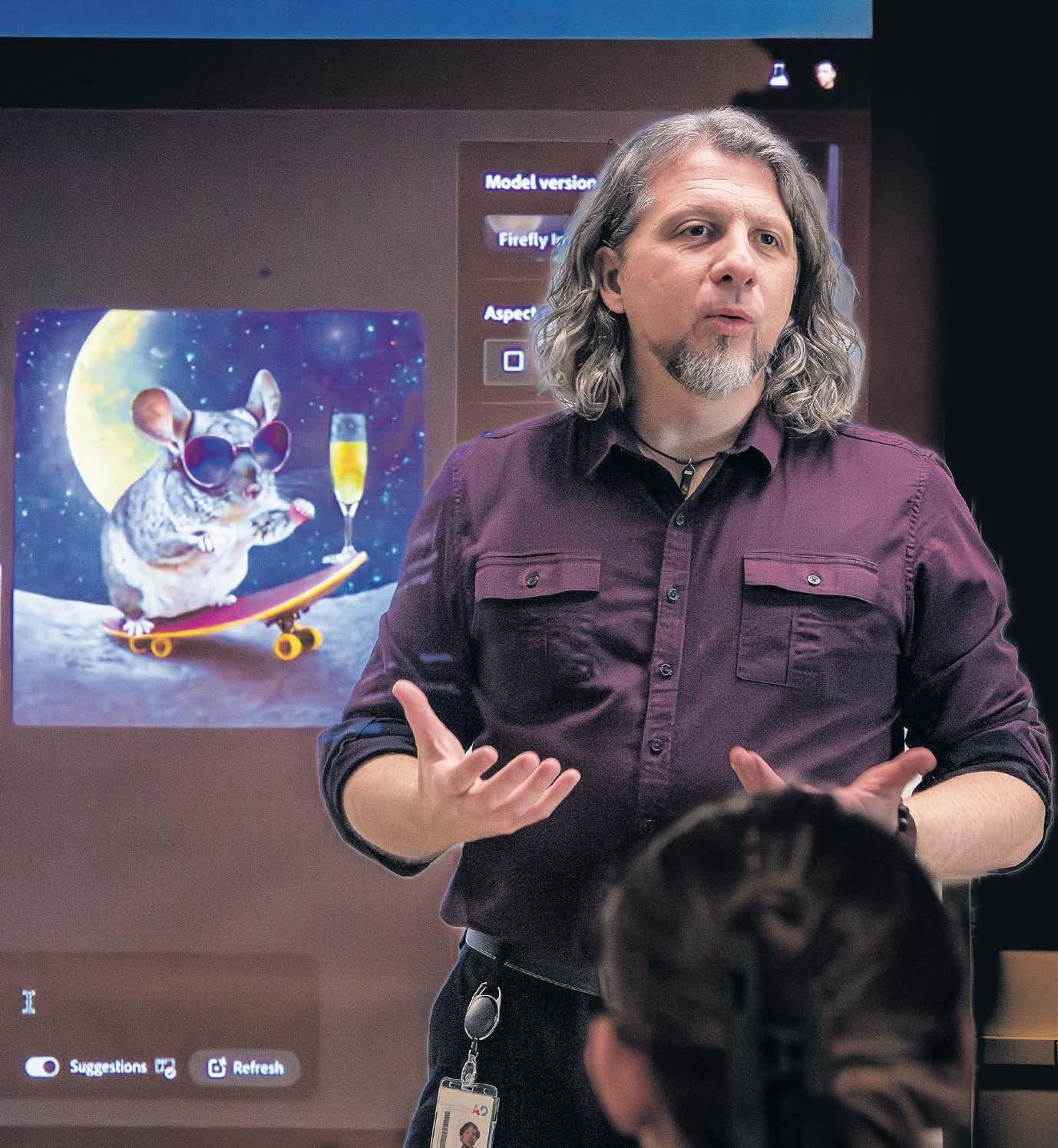

MARCH 3, 2024 • 7 PROGRESS LANCASTER COUNTY
Rich Johnson, a professor at Pennsylvania College of Art & Design who specializes in graphic design using Adobe software, stands next to an AI-generated image created by giving prompts to Adobe Firefly.
PAGE 8
|
BLAINE SHAHAN
STAFF PHOTOGRAPHER

ART AND INTEGRITY
How PCA&D and its students are navigating AI’s complex creative and legal challenges
ASHLEY STALNECKER ASTALNECKER@LNPNEWS.COM
When artificial intelligence developed the ability to create images, Rich Johnson started asking his students at Pennsylvania College of Art & Design for their perspective on the technology.
Johnson, an assistant professor of digital media whose expertise is in using Adobe software for graphic design, tread cautiously into the realm of AI technology in the 202324 fall semester. He told his students to hold off initially on downloading beta Adobe software incorporating AI until he could test it out first and bring it to the class for discussion.
But, as he and other creatives are
quickly realizing, AI is rapidly evolving and — through image generation — can blur the lines of ownership over artwork. It also poses challenges to academic integrity and the future of arts as a profession.
“The whole challenge of AI is it’s a moving target,” Johnson says.
Johnson was invited to be part of a newly created subcommittee of PCA&D’s academic policy committee dedicated to discussing and creating policies that govern the use of AI in student and faculty work. The goal is to reassess existing academic integrity policies in light of the potential impact of AI and to put in place a new policy by the end of the academic year.
Mainly, Johnson says, AI should be about “assisting not creating.”
“The ultimate goal of the policy committee work is for students to feel comfortable producing work that uses AI tools responsibly and transparently — to know when its use is appropriate and when it is not,” writes PCA&D Dean of Faculty Linda King Brown in an emailed statement. “We want faculty to feel confident that there are policies in place to guide and support them when assessing student work in the increasingly complex environment of AI-generated material.”
Among artists, feelings about AI are mixed, says Deborah Obalil, president and executive director of the
Association of Independent Colleges of Art & Design, of which PCA&D is a member.
“One camp is: This is happening, this is moving forward whether you like it or not,” Obalil says. “And wouldn’t it be better if artists and designers were intimately involved in the shaping of it than not. ... And then you have the other camp that still very much only sees the challenges and the problems with it and wants a hands-off approach.”
‘Legal nightmare’
Fair use laws and issues with ownership over intellectual property are ART, page 9
8 • MARCH 3, 2024 PROGRESS LANCASTER COUNTY EDUCATION
Rich Johnson, a professor at Pennsylvania College of Art & Design, created these images using Adobe Firefly, a generative AI web application. He asked Firefly to create a chinchilla who is skateboarding on the moon with purple sunglasses.
BLAINE SHAHAN | STAFF PHOTOGRAPHER
Art
Continued from 8
a long-standing challenge for artists and creators, especially in the western capitalistic market structure, Obalil says.
“It’s not just about intellect like who owns it or who created it and getting credit, but it’s very much tied to the compensation models of these images, who is making money off of these images,” Obalil says.
Generative AI is a subset of artificial intelligence focused on content creation and is trained using large datasets of images. In the training process, the AI algorithms learn different aspects and characteristics of the images it’s seen to create new images bearing similarities in style and content to those found in the training data.
Programs like Lensa and DALL-E generate images from text descriptions and prompt inputs.
However, artists often have not explicitly consented to have their original artwork used in training the AI generators, nor do they receive income from the new images that are generated.
Lensa, for example, takes a user’s selfies, studies them and churns out computer-generated portraits of the user in different styles. Some images still contained the signatures of the artists whose artwork trained the generator.
“It’s kind of a legal nightmare,” Johnson says.
Omar Almanzar, a junior animation and game art major at PCA&D, says he doesn’t use AI and is concerned by how its ability to mimic original artwork might evolve in the future.
“Being a professional creative can be hard enough,” Almanzar, a Lancaster city native, writes in an email. “Plagiarism is still a constant issue among human creatives, and the addition of another form of shortchange or theft is very concerning.”
Recently, he says, he’s turned to
documenting the time and place of his creative efforts to safeguard his work, but he worries that even that safeguard will become irrelevant.
Johnson says he tries to teach students techniques to protect their work such as using a new tool, Nightshade, that can scramble the metadata in an image to tamper with the training data so it damages future iterations of generated images. Metadata is used to summarize basic information about images or other forms of data, like where and when the data was created.
“So when I say I want a dog on a surfboard, you might get a scrambled egg on a surfboard,” Johnson says.
But AI is evolving and changing so rapidly, Johnson says, that that technique could be ineffective in mere weeks.
“That is at the crux of the real challenge of AI that is different from previous technological changes,” Obalil says. “Arts and design as a discipline has seen technological evolution over time but it has never been at this rapid pace.”
From a policy and regulatory perspective, AI’s rapid evolution is a critical concern, Obalil says.
Academic integrity
While PCA&D wants students to experiment with AI and even become versed in it to appeal to future clients, the college puts an emphasis on learning and developing skills that are assessed continuously, PCA&D Provost Carissa Massey writes in an email.
“Art students are assessed on their progress, which means AI presents a different challenge for us than it does for more traditional academic programs,” Massey writes. “We can say that, through our student-centered pedagogy … we are set to embrace AI as a tool for students to add to their professional skill set.”
Massey writes that she and the college are confident that faculty
can pinpoint from early on when academic integrity may be in question. That means something different depending on the specific art form but, for example, in Johnson’s class it might look something like a student trying to pass an AI-generated image off as their own.
That hasn’t happened yet, Johnson says. But, if it were to happen, he could identify it. And, he has been called into other classes to identify cases where students might be trying to pass off AI-generated work as their own.
“There’s something when you look at it you just know,” Johnson says. For example, he says, wrinkles on a face might seem too deep or a person’s skin might be glowing too much.
The running joke, Almanzar writes, is that AI can’t draw hands. Sometimes, a figure might have six or four fingers rather than five.
All that aside, Johnson says he does have a method to ensure academic integrity.
In Johnson’s classes, a student’s original concept, such as a detailed sketch, must match whatever the final product may be. Therefore, it would take much longer for a student to replicate their original concept through AI than it would to simply produce the artwork themselves, he says.
Beyond student academic integrity, Massey writes that the college is also concerned with the integrity of its prospective faculty and whether they might be passing AI off as their own work.
All studio faculty must provide a portfolio of their work and samples of student work in pursuing employment at PCA&D.
“Now, we need to account for how AI may be used by faculty in authentic and potentially inauthentic ways as we assess their potential as candidates,” Massey writes. “This means there may be a drawing, painting or design-thinking demonstrations incorporated into their campus interviews, alongside of our tradition
of asking for teaching demonstrations.”
‘An easy out’
With AI image generation being easy, quick and cheap enough that manufacturing an entire artistic portfolio is a concern, as Massey describes, there is a real threat to the job market that PCA&D is sending its students into.
The development of AI has creators across the board worried that they might be replaced, Johnson says.
“But I would say that it’s like any other time the paradigm shifts,” he says. “You just have to outperform it.”
AI misses the nuance, he says. Art, Johnson says, is a “culmination of a lifetime of strengthening your perceptions” that is far beyond the reach of AI.
“There will always be a need for artists and designers,” Obalil says. “What they’ll be specifically doing and what skills they’ll be employing are likely to change over time.”
That just leaves art institutions like PCA&D to fill in the blanks of how AI might be used as a skill set that employers look for.
The job market isn’t Almanzar’s main concern, though, he says.
“As of now AI still needs a point of reference, so real art is still a relevant source of creativity,” Almanzar writes.
Instead, he says his concerns come from the profit that is made without attribution to its sources and the degradation of human creativity.
“My own fears lie in the idea of using AI as an easy out,” Almanzar writes. “You can’t replace true human creativity and trying to do so with something that is good enough will not succeed in the long run.”
Companies, he writes, have to work with artists and not against them.
“Creatives are the ones with the tools and perspective to guide the brush,” Almanzar writes. “And, if AI is seen as another medium, then those possibilities can grow.”
MARCH 3, 2024 • 9 PROGRESS LANCASTER COUNTY EDUCATION
‘FASCINATING OPPORTUNITIES’
Schools see the possibilities of AI for teachers and students alike
GAYLE JOHNSON FOR LNP | LANCASTERONLINE
Carlos Cruz tries to make Mendelian genetics research fun for students at McCaskey East. So, Cruz recently sent them on an imaginary trip to an ethereal world to study mythical winged creatures.
The instructor, who teaches International Baccalaureate biology, could have spent hours creating this 165-word, five-part question with answers and an accompanying data table. The task took seconds, though, because Cruz typed a generic query into ChatGPT, a digital artificial intelligence platform.
Cruz also listened to student suggestions as he entered information displayed on a large classroom screen. He then asked the program to come up with an original problem that followed IB question formats.
The software created the world of Zephoria, populated by extraordinary creatures whose wings contain either swirling patterns or stripes. This extra-credit quiz question sent students scribbling with chalk on their tables as they spent most of the 54-minute class period working together to solve this and other questions.
AI, which marries research and text predictions, has been around since the 1950s. ChatGPT, a digital platform released in November 2022, makes it readily accessible, spurring popularity in education and other fields.
“ChatGPT helps create original questions,” Cruz explains. Students can search online and usually find questions and answers already used in previous IB biology exams, he says. “Using artificial intelligence leads to brand new material.”
Boom or bust?
“There has been a general reaction

to AI that’s been twofold,” says Dave Parry, a School District of Lancaster board member who also teaches classes on the subject as a professor in the digital media department at St. Joseph’s University in Philadelphia.
“A: Students are going to use it to cheat, and B: ChatGPT is the technology that will change education,” Parry says. The truth, he explains, lies somewhere in the middle. “It’s not going to revolutionize education, but there will be changes, both good and bad.”
Forty-six percent of U.S. high school students in grades 10-12 use artificial intelligence, according to a June study from ACT, the nonprofit group that offers college readiness exams. The organization, which surveyed 4,006 pupils, reported that among the 54% of students who don’t use AI, 83% weren’t interested, 64% had no trust in the platform, while 55% said they didn’t know enough about AI to use it.
AI excels in pulling together formu-
laic information. It predicts text the same way smartphones or Microsoft Word try to predict words in a sentence. Parry calls it math for text. For instance, if you type this word first, and then another word second, what would the next word most likely be?
“It’s a computer-generated helper to be able to articulate expression,” explains Ken Zimmerman, associate program director for educational technology and innovation for Lancaster-Lebanon Intermediate Unit 13, an educational service agency serving schools in both counties.
Teachers can use AI to write emails to colleagues and parents, to create lesson plans and to align state education standards to their curriculums. They also can use it to check for bias or to check a student’s research paper for grammar, spelling and punctuation, leaving the teacher more time to focus on word choice, theme, tone and other writing aspects. Students may use AI to apply for
grants or scholarships or to create resumes. Pupils also may use AI to plagiarize work, but that’s something most teachers should be able to recognize when reading a paper or answers to a question because the language may be repetitive, Parry and other professionals say.
Instead, Parry urges people to think of AI as a co-pilot.
“It’s not driving the car,” he explains. “It’s sitting next to you, giving advice.”
Becoming mainstream
About 50 attended an in-person AI training session at IU13 in June, followed by a digital workshop in November.
AI “is going to have a large impact on learning, and we’re always looking to start conversations,” says Tim Leister, an IU13 instructional technology specialist who helped design
10 • MARCH 3, 2024 PROGRESS LANCASTER COUNTY EDUCATION
SUZETTE WENGER | STAFF PHOTOGRAPHER
SCHOOLS, page 11
From left, McCaskey East students Kaydence Canty, 17, Kazchmir Marmolejos, 17, Ella Proud, 16, and Jessiah Blakey, 17, work to solve a biology question from ChatGPT in the classroom of Carlos Cruz, standing right.
Schools
Continued from 10
the workshop.
The popularity of ChatGPT and other platforms signal that AI “is becoming mainstream,” Zimmerman says.
Megan Smith, an IU13 instructional technology integrator, says some teachers may fear that students will turn in other students’ work, but believes that fear is mostly unfounded.
“We support (AI) as a tool,” she explains. “It’s a tool for a kid who has writer’s block” and needs ideas.
How it’s in use
While most school districts allow teachers to use AI for themselves or in front of students, rules surrounding pupils differ. For instance, the School District of Lancaster is just beginning to delve into creating some sort of student policy, says Wes Emlet, who manages instructional technology for the district’s technology integration department.
“ChatGPT is thinking outside the box,” Emlet notes. “It can help students be more creative.” Yet pupils need parental permission to use AI on campus, and ChatGPT and other AI platforms set age restrictions to at least 13 years old and up.
Administrators need to work out a plan acceptable to school board members and student families, Emlet says. “If we were to open it to students, at some point we will get to that conversation,” he notes. “We need to encourage people to use it responsibly.”
Eastern Lancaster County School District received a state grant to pilot an AI program this spring with in-house educational devices similar to those people use at home, such as Microsoft’s Alexa or Apple’s Siri. These digital assistants will not use the internet and will keep student information safe, says Adam Geiman, an instructional technology specialist in the district.
Michael Snopkowski, Elanco’s superintendent, plans to move cautiously. “At this point, we’ll get through our entire pilot process and evaluate the experience before we do anything regarding next steps of presentation,” he wrote in an email. “Like other tools in our classrooms, we need to better understand how AI will support the learning of our students before making any decisions on embedding it in our district.”
AI will improve education, says Nicole Malinoski, superintendent of the Lebanon School District. “It’s going to make monumental changes in how we make assignments,” she says.
For instance, in addition to citing sources in a research paper, students soon may need to submit all prompts or questions they entered into AI along with accompanying answers.
“AI will help increase the problemsolving process,” Malinoski says. “It’s going to allow our teachers to challenge our students, to up the bar on what we expect from them.”
Small pockets of teachers use AI in Lebanon classrooms, says Shawn Canady, chief information officer.
The future
Some teachers needlessly fear AI will replace them, Parry says. That worry is unfounded, though. “It’s good at filling out forms. But it’s not feedback or personal interaction, which is why teachers will continue to be important,” he explains.
Geiman, from Elanco, mentions the early 1970s, when calculators became popular. “That didn’t stop math teachers from having jobs.”
Avoiding AI, though, might hurt a teacher’s career, Geiman says.
“AI won’t take your job,” he says, “but someone who knows it will.”
For now, educational professionals seem excited about AI’s future.
“Teachers are finding fascinating opportunities,” says J.P. McCaskey Principal Justin Reese.
“The amazing thing about this technology is that it’s ever-evolving,” Leister says.



























MARCH 3, 2024 • 11 PROGRESS LANCASTER COUNTY EDUCATION Cosmetology • Esthetics Massage Therapy • Nail Technology 50 Ranck Avenue • Lancaster, Pa | 717.299.0200 99.0200 Job placement assistance provided to all graduates. Financial aid available for those who qualify. For a complete list of services and hours visit us at www.lancasterschoolofcosmetology.com Where Beauty & Wellness Meet Celebrating 45 Years! 50% OF F any hair or nail service. With this ad. Cannot be combined with other offers. All services performed by supervis ed students.




PURSUE a “home” that celebrates you... today & tomorrow
As a trusted pillar in Lititz, Moravian Manor Communities celebrates the journey of living with abundant opportunities to pursue what matters to you … whether it’s a fulfilling career, maintenance-free lifestyle, or supportive health care.
A Career with Purpose!
We recognize Excellence In Customer Care and reward team members for their hard work. Some of our staff have been with us for 20+ years! Apply today at www.moravianmanorcommunities.org/careers.


An Enriched Life!


With two campuses in Lititz and four residential home styles (Apartments, Carriage Homes, Cottages & Townhomes), residents are pursuing inspired lifestyles surrounded by first-class amenities and ser vices.
An Engaged Life!
Within our supportive neighborhoods, from assisted living and memor y care to skilled care and short-term rehabilitation, residents enjoy a wide range of programs that foster a sense of community and connectivity. you’re a ated
If you’re searching for a celebrated community in which to work or live, we’d love to see you here!


12 • MARCH 3, 2024 PROGRESS LANCASTER COUNTY COMMUNITY
71 76 26 0 214 • mor avia nma nor commun ities.org Residential Living • Assisted Living • Personal Care • Memor y Support • Skilled Care • Short-Term Rehab
COMMUNITY
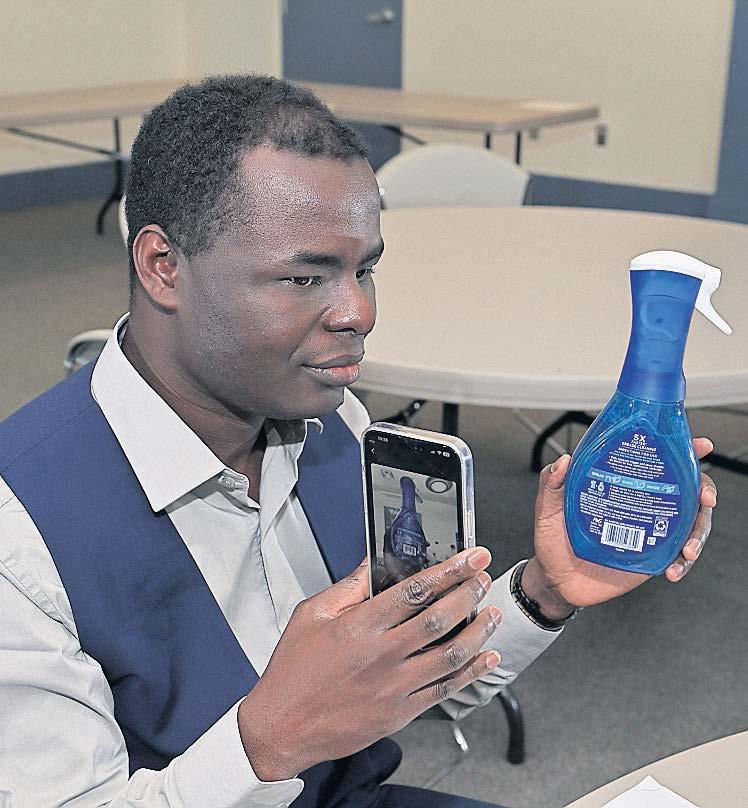
SPONSORED BY


MARCH 3, 2024 • 13 PROGRESS LANCASTER COUNTY
Benjamin Brenya, an access technology specialist at VisionCorps, who is also blind, uses a smartphone app called Seeing AI to identify the bottle of Dawn dish soap in his hand.
17 SUZETTE WENGER | STAFF PHOTOGRAPHER
VisionCorps also uses AI to improve workflow.
PAGE
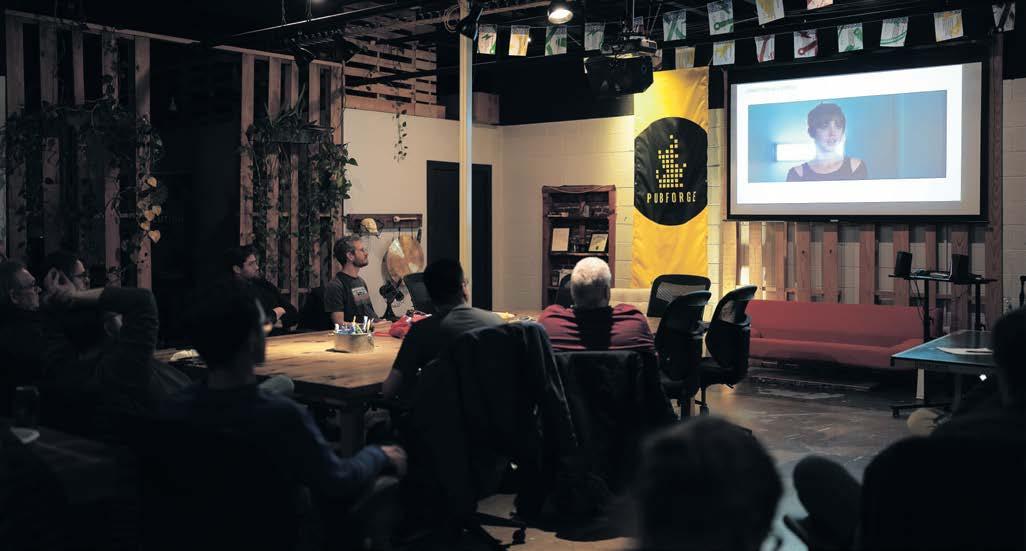
A growing community
As many as 30 people currently show up each month to discuss research into how humans are building and interacting with AI in sessions like “Generative AI Simulacra” and “Creating Generative AI Videos.”
“One thing I’ve liked is that because AI is such a hot topic right now, the Lancaster AI meetups have brought in people who are new to the area or weren’t previously plugged in and introduced them to the amazing tech community that we have here,” says Michael Irvine, a 29-year-old from Lancaster city who has co-founded Delphi Labs, an early-stage AI data analytics startup based in Lancaster.
AN ‘AMAZING TECH COMMUNITY’
Lancaster meetup group sees exponential interest in monthly AI discussions
LISA SCHEID LSCHEID@LNPNEWS.COM
For years before ChatGPT, a handful of Lancaster County engineers and programmers met monthly to learn more about machine learning, deep learning, robotics and any other form of artificial intelligence.
They gather at PubForge, a seven-year-old technology co-working space on East King Street. The group calls itself “Lancaster AI, a meetup for artificial intelligence in Amish Country.”
Interest in the group changed after ChatGPT, the AI text chatbot made by the company OpenAI, was released as a free web-based tool in late 2022.
Attendance grew exponentially, according to founder Rich Everts, who is a frequent presenter.
Everts, who has been an artificial general intelligence researcher for more than two decades, thinks 2024 will be a transformative year for AI as more people in different occupations adopt the technology. Artificial general intelligence is a branch of AI that seeks to build systems that perform as well as or better than humans, including reasoning, planning and the ability to learn from experience.
In 2018, the group joined about a dozen other cities in running a free, internationally organized 10week program on AI, which was
led by Everts.
Everts’ work in AI grew out of a personal need to help his disabled son who is nonverbal and autistic. Having ways to recognize his son’s patterns could help caregivers understand his needs.
Everts was co-founder and director of the Tommy Foundation, a nonprofit focused on education, advocacy and services for families affected by autism, from 2005 until it closed in 2023. He is also an award-winning filmmaker of “The United States of Autism,” a documentary that chronicles an 11,000mile journey across America in 40 days, telling the stories of 20 families from all walks of life who are living with autism.
Software consultant Luke Demi, 34, of Lancaster city, says he thinks the AI group is an important part of the county’s broader tech community of which he is an organizer. Demi says the group used to meet at a co-working space in Lancaster city.
“When AI was first very hot on the scene, we started meeting every single Thursday for lunch at The Candy Factory to build a shared understanding of these technologies and how we could use them in our jobs,” Demi says. “We’d have 10 to 15 people each time, and usually one of us would present on a recent topic or technology that was new. It was cool to watch everyone grow together and get on the same page. Over time the technology has matured and folks are all on the same page (in less than a year!) so the group has moved to a pizza/beer group on one Thursday night a month.”
Demi says the county’s entire tech community in Lancaster is growing.
“I think a lot of people who used to live in the Bay Area or New York City, like myself, to be in close proximity to large tech companies have kind of spread out across the TECH, page 15
14 • MARCH 3, 2024 PROGRESS LANCASTER COUNTY COMMUNITY
CONNOR HOLLINGER | FOR LNP/LANCASTERONLINE
Rich Everts shows a short clip from the movie “Blade Runner 2049” during a recent Lancaster AI meetup on the topic of AI companions at PubForge in Lancaster.
Continued from 14
U.S. with the remote revolution,” he says. “Lancaster is a very attractive place to settle down for people (similar city amenities) but people need that social connection they used to get from their office. Tech Lancaster and the AI meetup help fill that need for everyone.”
New tools and techniques
The enthusiasm and pace of local AI interest is impressive, says Nathaniel Evry, 33, of Mountville, a lead systems engineer for a company that specializes in supplying the manpower to guide traffic safety around work zones.
Evry says AI simplifies the busywork in information technology at his employer, Berks County-based AWP Safety. It transforms tasks like creating Excel tables or optimizing repetitive code into efficient processes.
“AI assists in building robust checklists for projects, ensuring accuracy and saving time,” he says.
Irvine says the group has exposed him to new tools and techniques in AI.
“For example — text-to-speech models I didn’t know about and ways to run AI models locally on your own computer,” he says.
Delphi connects AI large language models like OpenAI’s GPT-4 to enterprise data sources.
“We aim to make it 10 times easier for businesses to make sense of their data by using AI to automate data science tasks like reporting, chart generation and root cause analysis,” Irvine says. “Current AI tools like ChatGPT are great toys and can be really helpful, but they aren’t yet accurate enough for businesses to rely on for critical decision-making. We’re focused on changing that.”
He spends most of his time writing code (software engineering) so
he uses AI tools like GitHub Copilot every day.
“Sometimes 50% or more of the code I write in a day is probably written by AI,” he says.
He’s found Lancaster AI is a great way to share ideas and best practices and ask questions to a group of people who are on the cutting edge of the recent AI developments.
Demi says the meetups help him to be at the very forefront of what’s happening in the industry to be effective when making recommendations to clients.
Technologists/software engineers always get excited any time there’s a major technology leap such as the internet, mobile, cryptocurrency and AI, he says.
“The AI leap feels like one of the more accessible leaps of my career — anyone (software engineer or not) can sit down and try ChatGPT without any special knowledge and essentially be using the most advanced tool that is available in the world to anyone,” Demi says. “It’s only a few additional steps to start learning how to tune the way you frame questions to the AI and try to push the technology to its limits.”
Driven by a fascination with technology, Evry taught himself AI.
“The advent of ChatGPT in December 2022 was a game-changer, increasing my work productivity by 83 times in 2023,” he says. “AI has revolutionized my workflow, allowing me to focus on my strengths while efficiently handling documentation and structure in my research across various fields. I’m currently working to teach AI how to work with people better. I’ve been training a few AI agents to be more flexible and try to understand our questions and requests.”
For the record, Evry can say his productivity increased 83 times because it helped him code the tools that could measure his code writing.

A diver se age 55+ r enta l co mmu ni ty in a walkable cit y


HIGHLIGHT S
Two bedroom apar tments star ting at $2,200/mo
Ne w constr uction close to attr actions inc luding Centr al Market and Fulton Theatre
Age 55+ living with no entr ance fee
Outdoor terr ace with beautiful vie ws, fitness center, on-site Care Navigator, and first-floor restaur ant, The Rende zvous
Cal l 717.928.8988 to sc hedule a tour!
Leasing Partne r

MARCH 3, 2024 • 15 PROGRESS LANCASTER COUNTY COMMUNITY
Fe w Ap artments
ft! Vi sio nar y URBA
Tech Only a
Le
N LI VIN G
Social Impact Investment Partner Para información en español, llame al 717.509.5400 239 West King Street | Lancaster, PA 17603 LandisPlace.org | 717.928.8988






ess King grew up in Lancaster County, in a family with deep Amish and Mennonite roots. Her family owned a local paint store where she and her siblings worked, starting in elementary school. The paint store sustained them, taught the lessons of hard work, and enabled the kids to graduate from college, the first in their family to do so
King’s father was killed in a plane crash when she was a baby, but she says this tragic event fostered a narrative in her family that “life is short, and you need to make it count.”
These trio of experiences - growing up Mennonite, in a family business and losing her father - have guided King’s life and forged her dedication to Lancaster County. “This place really matters to me,” she says. “I believe in finding solutions for the common good.”
King is the new executive director of The Steinman Institute for Civic Engagement, a nonprofit overseen by WITF and funded by a seed donation from The Steinman Foundation
The Institute has two main goals: supporting the supply of local journalism in the 19-county footprint of WITF and boosting the community’s

Jess King’s Journey: The Steinman Institute for Civic Engagement
relationship with local news media.
The Institute is finalizing a calendar of community events with LNP and WITF to foster civic engagement “We want to inform and engage the community in service of building stronger communities,” King says Check Steinmaninstitute. org in early March for more information.
“This is a time of unprecedented change in local media,”
JESS KING
The Institute will also be developing communityfacing tools for civic engagement, such as an online resource where residents can learn more about their government
The Institute also aims to expand the voice of the




county’s youth by working with local high schools and colleges to have students create content that elevates their perspectives.
This all matters to King partly because of her family’s longstanding engagement with local news as subscribers and advertisers. Local news, King says, “reminds us of our own agency and the ways we can make our community stronger.”
The facts back King up. The Local Journalism Initiative in Delaware* found that when communities lose their source of local news, the cost of government borrowing rises, police clear fewer violent crimes, and voter turnout drops. All because there is no news media serving as a local watchdog to surface information that might be hidden from the community.
Reversing the decline of local news is a tall order, but King feels up to the challenge. “Growing up Mennonite, I learned that one of our biggest responsibilities is to love our neighbors as ourselves, across differences, across ideologies, across divides,” she says “The Institute will help advance this type of thinking, and I’m thrilled to be here at the start of it all.”
*Ljidelaware.org/why-does-local-news-matter
16 • MARCH 3, 2024 PROGRESS LANCASTER COUNTY COMMUNITY
A HELPING HAND FOR NONPROFITS
For some, AI technology not only advances the mission but also improves the workflow
RACHEL CURRY FOR LNP | LANCASTERONLINE
In most ways, nonprofit organizations are unlike other industries, but there’s one key avenue where they’re following protocol. By embracing artificial intelligence, nonprofits big and small, local and global, are finding their footing in a technologically progressing world.
From a global scale, you’ll see nonprofits like Canadian drug discovery organization Conscience using AI to predict drug targets, an effort funded by noteworthy names like the Michael J. Fox Foundation. Zoom in to the local arena and you’ll find nonprofits doing work in Lancaster and the surrounding area, using AI to streamline their operations and enhance their offerings for a wellrounded leap into the future of technology.
Take VisionCorps, for example. Located on Queen Street in Lancaster, VisionCorps is a nonprofit helping folks with vision loss to live and work independently. In their recently renovated Technology & Accessibility Center, VisionCorps offers training for cutting-edge technology services. This training assistance helps blind or vision-impaired individuals get over the learning curve and start using tools that may improve their standard of living.
Digital visual assistant platform
Be My Eyes has an AI component that is currently in the beta testing stage. Microsoft’s Seeing AI is an app for blind and vision-impaired people that helps them better navigate the world. OKO by Ayes, a navigation app for people with vision loss, also leverages AI to function. All of these apps are available for training at VisionCorps with the help of their technology assistance coordinator, Benjamin Brenya.

Carol Gifford, community relations and public affairs manager at VisionCorps, also uses AI to fill the gaps in her own work. Gifford uses Hootsuite, a social media management tool, which now has a generative AI feature called OwlyWriter AI. This helps people come up with post ideas and form captions, easing the brainstorming process and allowing nonprofits like VisionCorps to get more work done without more staff.
This idea of doing more with less is important for nonprofits. According to a 2023 survey from the National Council of Nonprofits, 51.7% of nonprofits reported more job vacancies now than prior to the COVID-19 pandemic. Because of this, 28.1% reported longer waiting lists for services.
Despite fears of AI technology taking jobs, this is one instance where AI is simply filling wide gaps in productivity to better serve people.
Fundraising and educating
All Star Code tackles accessibility from a different lens. It’s a nonprofit organization focused on closing the opportunity gap for young men of color by teaching them the skills they need to succeed in the technology sector. Based in New York, All Star Code has had in-person summer programming in Lancaster for the last few years.
To help raise money for the organization, All Star Code launched a digi-
tal art collection partially generated by AI, with proceeds from the sale of this art funding the three- and sixweek Summer Intensive web development coding programs, which are free for students.
Plus, as All Star Code’s Director of Marketing & Communications Tony Stewart says, “Our students will stand at the vanguard of technological innovation as they enter the workforce, and we want them to be prepared for what may come.”
Stewart says that he’s noticed a trend among students in other programs using AI chatbots to complete assignments, but says the work at All Star Code is different.
“We aim to set a standard in com-
MARCH 3, 2024 • 17 PROGRESS LANCASTER COUNTY COMMUNITY
SUZETTE WENGER | STAFF PHOTOGRAPHER
NONPROFITS, page 20
Megan Tomshenk, vice president and chief development officer at VisionCorps, uses Hootsuite with a generative AI feature that helps come up with post ideas and form captions. It’s a way for the nonprofit to get more work done without more staff.
A TECH LAWYER TALKS AI
‘It’s really going to impact almost every job you can think of’
CHRIS REBER CREBER@LNPNEWS.COM
As founder of Lancaster Tech Law, attorney Brandon Harter helps companies deal with legal cases involving data breaches, software licensing, copyright infringement and other tech-related issues.
With the rise of chatbots like ChatGPT, clients at the East Hempfield Township-based law firm have had more legal questions involving artificial intelligence.
Harter says that court rulings around AI are evolving rapidly, like the technology itself, and will continue to do so in the coming years.
He is also interested in using AI in his own firm, which he founded in 2022, to make the practice of law as efficient as possible.
Harter spoke with LNP | Lancaster Online about the possibilities, concerns and legal issues he is seeing around AI as it grows in popularity. The interview has been edited for length and clarity.
Is AI a growing part of your firm’s work?
AI is one of those technologies like email and text messaging that is going to touch almost every industry. It’s just a question of how it does that. People have the impression that certain jobs will be replaced and everybody else will be fine. But whether it’s generating images, text, or summarizing materials, it’s really going to impact almost every job you can think of.
Are there a lot of businesses using AI locally, and in what applications? How are they benefiting from it?
A lot of companies are using AI to draft blog posts, marketing pieces and correspondence. A lot of times it
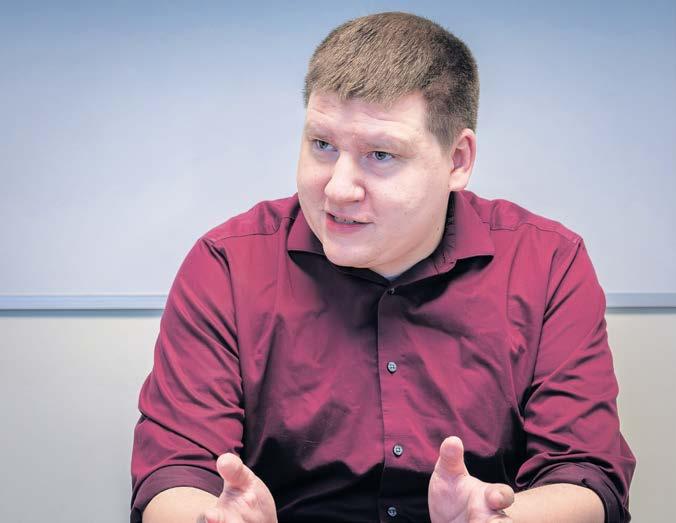
questions about whether AI-generated content can be copyrighted. It’s not unique to you. A human didn’t create that content. You want to be careful about relying on it too much for generating logos and things like that. If it’s really important to you, maybe don’t let the AI do all of the work.
My guess is that courts will say — if you make a prompt and it creates something that has never been seen before, you’re probably going to have legal rights to it. And if you tell it to, for example, write a song with lyrics like Snoop Dogg, you won’t.
AI is being used a lot in hiring to screen applicants and resumes. What are the benefits of that, and what are the potential issues with bias and discrimination?
is some young and hungry people at the bottom of the company.
Companies looking to implement it in their systems overall are the minority, but they exist — in health care, summarizing medical records; banking, where it’s part of the decision process; law firms summarizing documents.
There are a lot of creative applications. A company I work for has fed an existing set of blog posts into a “chatbot” on their website. Instead of using ChatGPT and answers from the entire internet, it only answers from their own content.
It makes for better automated customer service. It avoids hallucination, which is when the AI makes something up if it doesn’t know the answer.
AI systems are “cocktail party smart.” They can talk like a doctor or lawyer and mimic what a good
response would be, whether or not the content is perfect. There was a recent high-profile case where a lawyer was sanctioned because he used AI to write a brief, and it cited court cases that don’t exist. You’ve got to be careful.
What potential liabilities are you issuing warnings about to companies considering using AI?
The most basic thing is to read and fact check the content that AI generates.
The second thing is thinking about where it got the information it is summarizing. There are industryspecific AI tools, medical ones that pull from medical journals to make diagnoses instead of looking at Reddit.
The last one is, companies need to be careful from an intellectual property standpoint. There are serious
A lot of companies, including local ones, are using AI to filter through resumes, especially when they use online platforms which generate a lot of applicants. It’s useful for large, complicated organizations, as well as the small bakery that doesn’t have time to look through 100 resumes every time they hire.
They are very useful, but you have to be concerned that they’re not filtering out certain groups of people. For example, if you feed an AI the last 100 years of employment data, there are going to be past decisions that are not desirable in the modern context — that were based on race, based on gender. Programmers may not be trying to eliminate someone because of the color of their skin, but if the data set comes in that way, AI will mimic what it is taught.
What are the privacy concerns around using AI for businesses?
You need to be careful about what TECH LAW, page 20
18 • MARCH 3, 2024 PROGRESS LANCASTER COUNTY COMMUNITY
BLAINE SHAHAN | STAFF PHOTOGRAPHER
Brandon Harter, of Lancaster Tech Law, talks about artificial intelligence during an interview in his East Hempfield Township office. Harter has been advising the local business community on emerging issues related to AI.
Bright Side Opportunities Center: A Vision to Empower a Bright Future
For 20 years, in its current location, the Bright Side Opportunities Center has been living up to its mission to provide opportunities for all ages, from birth to seniors.
“We are dedicated to individual achievement and to strengthening the community through collaboration and programs that are educational and inclusive,” says President and CEO Willonda McCloud.
An outgrowth of Bright Side Baptist Church in Lancaster and the vision of the Rev. Dr Louis A. Butcher Jr., Bright Side Opportunities Center is located at 515 Hershey Ave., in southwest section of the City of Lancaster.
The vision for the center is to empower, impact and influence the community for a positive purpose, McCloud says. Their values focus on diversity, respect, integrity, servant heart and collaboration.
Since joining Bright Side Opportunities Center eight years ago, McCloud has led a staff of four full-time and four part-time employees, along with many volunteers, in living up to Bright Side’s mission.
“That mission is to act courageously, serve with empathy, promote teamwork and lead by example,” McCloud says.
From the youngest children, who attend preschool and childcare at Village of Love housed in the Bright Side Baptist Church To teens who learn through Science Education Technology and Math (STEM) education programs To seniors who participate in fitness programs, Bright Side Opportunities Center is rich in opportunities for members of the community in all stages of life.
There is a special emphasis on young teens, and especially girls of color, to help prepare them for careers in coding, that will allow them to earn a sustainable wage in the future.
“So many times, girls are told that they cannot excel in the sciences and math. There are only 2% of computer science graduates who are women of color. Our STEM programs, give them the confidence and competence to pursue careers in STEM,” McCloud says.
“We are very excited about the Girls Who Code summer intensive program,” says McCloud, noting that the intense six-week computer science course has been developed for girls in grades 9-12, that allows

them to learn and earn a summer stipend.
STEM camps for boys and girls are held during the summer months Our goal is to instill hands on career readiness skills, essential for success in STEM fields and beyond, ensuring a diverse and innovative workforce in the future.
At the other end of the spectrum, seniors benefit from programs designed to keep them healthy and fit, like strength and conditioning and Silver Sneakers exercise programs which are free through they health insurance.
The Bright Side Opportunities Center will hold a free Health Fair and Fitness Expo for the community from 10 a.m. to 2 p.m. Saturday, March 23, featuring food, vendors, fitness demonstrations, health screenings and informative talks with health care providers, in the Diva Den and Man Cave. Childcare will be provided. One such featured speaker will be, Dr. Terre Quinn of Dallas, Texas, the current Ms. Senior America and a board-certified general surgeon. Additionally, Sally Winchell, Bright Side’s wellness director and current Ms Senior Pennsylvania, will offer fitness classes. In September, Bright Side will host its annual
Sneaker
formal
and comfortable
The gala will include awards given to community members and organizations, dinner, a live band and dancing.
Bright Side Opportunities Center relies on a variety of sources, including grants, private donations, and sponsorships to help achieve its mission.
“We believe a strong community is made up of healthy individuals and focus our efforts on providing opportunities for people to thrive emotionally, physically and intellectually,” McCloud says
To learn more, visit brightsideopportunities.org or the Facebook page

MARCH 3, 2024 • 19 PROGRESS LANCASTER COUNTY COMMUNITY
Ball fundraiser, where guests wear their best black-tie
attire
sneakers.
From Left, Sally Winchell, Aida Rodriguez, Willonda McCloud, president & CEO, Isiah Perry and Gena Smith.
Continued from 17
puter science education by responsibly adopting and exploring these emerging technologies,” he says.
Stewart is an active advocate for representation and inclusivity, and he sees AI as a way to democratize technology regardless of who you are and where you come from.
See the possibilities
For nonprofit leaders that want to implement AI — whether to improve their own workflows or broaden the ways they can serve their communities — they must first understand how to use AI. This is an obstacle that the team at United Way of Chester County (UWCC) is tackling.
UWCC brought on Kelly Cockshaw as director of leadership and innovation in 2023 to build its Social Innovation Lab from the ground up. The Social Innovation Lab, Cockshaw says, is a series of initiatives that helps build the capacity of area nonprofits through the latest technological trends like AI.
As part of these initiatives, UWCC hosted an AI for Impact workshop in November where the organization invited other nonprofits to join in on an interactive learning experience about using AI in their own work. In partnership with Penn State’s

Nittany AI Alliance — a collective connecting students with industry leaders — student groups brainstormed possible AI solutions to specific nonprofit problems or concerns.
“People have really different perceptions of AI. It’s overwhelming. It’s scary,” Cockshaw says. “What we really wanted to do was to take away that level of overwhelm and just let everyone know what the art of the possible would be.”
For nonprofits pursuing AI usage in any capacity, Cockshaw urges them to consider data privacy so they’re protecting the information of the people they serve. Once that’s in place, solutions like managing datasets, generating content, managing incoming questions with chatbots and more can all be done by leveraging AI technology.
In the AI renaissance, the notion of progress takes on a shape of its own. But it’s not just big corporations and individual users that benefit. Nonprofit organizations helping their communities also have the option (and perhaps the responsibility) to incorporate the latest technology if it furthers their mission in a safe, responsible way.
In Lancaster County, neighboring regions and far, far away, nonprofits are functioning differently today because of AI — and this is just the start.

Tech law
Continued from 18
is being transmitted out. Are you feeding it information about marketing, pricing information, or customer communications? What is the AI allowed to do with that information? Are they allowed to sell it to other people?
AI works best when it has more to learn from, so they tend to want to grab as much information as possible. It’s easy to leave the door open, allowing it to grab more than you might want.
What are the laws around data privacy in Pennsylvania? Are they more or less strict than other states?
Pennsylvania 100% needs a more updated set of regulations about data privacy, and AI in particular. It does require companies to notify customers if data is stolen, but only when a specific combination of information is involved — like a bank account and a full name. The protection also stops when the company notifies the customer. There’s no punishment, no sanction. That’s not truly protecting anybody’s privacy.
What are the ways that hackers can use AI that people and businesses should be aware of?
There is the impression that a hacker is one person, but it is actually an entire industry with multiple levels of sophistication. There are people who write code, and other people who collect data. In between there is the real criminal layer, which buys the software, buys a customer list from the dark web, and automates it to attack a large number of people quickly.
AI is really good at taking large pieces of information — such as Social Security numbers and addresses — and summarizing it in a way that’s dangerous.
Are companies using AI for sur-
veillance and productivity tracking, and what are the issues there?
At the end of the day, the danger of AI is its power. Humans can pull together information and build a profile, but the difference is the amount of information that can be reviewed, and the speed. One example is police surveillance. Most people are OK with police following a car if they suspect something criminal is going on. They’re OK with traffic camera footage being assembled to investigate a crash. But what if that information is fed into an AI program, and used to track someone in real time using facial recognition? That’s where AI gives sort of a superpower that makes people nervous, and should make people nervous.
AI is making big waves in education. Are there reliable AI detection tools out there, and could their use by schools or businesses create liability issues?
It’s very challenging in high school and college, where you’re writing more complex papers. Direct plagiarism is easy to detect. AI generated text is much more complicated. If a student starts with AI, and finishes the paper themselves, could that be OK? In a workplace application it is. Of course, teachers may give specific instructions to not use generative AI, because they want their students to prove they can do the work without that shortcut.
In general, what are your feelings about the recent advances and the growing potential for AI with chatbots like ChatGPT?
Generative AI is going to be a leap forward in efficiency, and do something meaningful with the massive flood of information we are given on a daily basis. It can free us up to do other things, and help us as a society moving forward. There are definitely going to be growing pains, like with any technology, but it’s a really exciting technology to improve the way that we work, play and live our lives.
20 • MARCH 3, 2024 PROGRESS LANCASTER COUNTY COMMUNITY
Nonprofits 59 W. Main St • Leola, PA 17540 www.FurmanFuneralHome.com 717-656-6833 Home for Funerals Since 1952 Modest Funerals • Plain Coffins Philip W. Furman, F.D.






















































































MARCH 3, 2024 • 21 PROGRESS LANCASTER COUNTY COMMUNITY Local Dining Welcome to McCleary’s AR el axed At mosp he re Ye ar Roun d! LIVE MUSICWed - Sat Year Round! 130 W. Front St. Marietta, PA |717.426.2225 |mcclearyspub.com 280 West Front St., Marietta 717.426.4141 |railroadhouseinn.com Dine with Us, Stay with Us, Make Your Event Memorable Herewith Us. Wed& Thu -4PM-9PM, Fri-4PM-10PM, Sat-4PM-11PM, Sun -10AM-3PM McCleary’s Pub 130 W. Front St., Marietta Casey Jones’ Restaurant 312 Paradise Lane, Ronks Railroad House Inn 280 W. Front St., Marietta Freshly Greek 2355 Oregon Pike, Lancaster 1 4 2 3 772 772 772 896 462 340 222 30 30 Ch ur ch S t. HarrisburgPike Fruitville Pik e McGinness Airpor East Petersburg Ma nheim Lititz Mt Joy Columbia Leola New Hollan d Lancaster Airpor Street 23 230 283 772 501 23 30 El izabethtow n Ephr at a 322 72 Smoketown Airpor t 272 322 1 4 2 3 NOWSERVING BEER, WINE, &COCKTAILS Voted best farm to table restaurant in Lancaster County 2355 OREGON PIKE, LANCASTER, PA FRESHLYGREEK.COM
Ma Co
Beyo serv
Fulfillin 2022, than

Between awarding scholarships to te and hosting interns, Masonic Village
Bleiler Caring Cottage (home for adults disabilities) 717-367-1121, ex t. 33751
Employment Opportunities 717-361-4522
Farm Market & Orchard View Café 717General Inquiries 717-367-1121
Home Care 717-361- 4999
Home Health 717-361- 4050
Hospice 717-361-84 49
Masonic Children’s Home 717-367-1121,
Outreach Program 1-800-462-7664
Pharmacy 717-361-5599
Nursing/Personal Care 1-800-422-120
Retirement Living 1-800-676-6452
Sell Chapel 717-367-1121, ext. 33106
Short-Term Rehab 717-367-1121, ext.
Volunteer Services 717-367-1121, ex t. 33

22 • MARCH 3, 2024 PROGRESS LANCASTER COUNTY HEALTH
One Masonic Drive, Elizabethtown, PA MasonicV illageElizabethtown.org
HEALTH
 SPONSORED BY
SPONSORED BY


PAGE 25
Area hospitals are discovering ways that artificial intelligence can assist with finding abnormalities in imaging and expedite patient care.
MARCH 3, 2024 • 23 PROGRESS LANCASTER COUNTY
GETTY IMAGES
KEEPING A WATCHFUL EYE
How area hospitals are using AI technology to help monitor patients
CAROLE DECK FOR LNP | LANCASTERONLINE
While many businesses embrace the advantages of AI to streamline processes, some question the disadvantage of AI lacking human emotion.
However, the health care field is seeing success with AI-generated technology for patient monitoring without limiting care or humanity.
WellSpan Health discovered a way to use AI to improve patient safety and address nurse burnout. The health system collaborated with Artisight Inc. in Northfield, Illinois, to use its Smart Hospital Platform powered by AI for a pilot patient monitoring and virtual nursing program.
The program has been used at WellSpan Surgery and Rehabilitation Hospital in York since mid-August.
Patients at high risk for falls are monitored 24/7 using patient-room audio and video connections by a virtual nurse tele-sitting in a designated control space to monitor behavior in each room. The virtual staff can interact with patients and ask assistance from an onsite clinician as necessary.
“The virtual nurse can monitor more patients at a time and is an extension of a registered nurse with the two working as a team,” says Kasey Paulus, senior vice president and chief nursing executive at WellSpan York Hospital.
She explains the camera uses AI to monitor normal movement and gives a visual color cue that shows on a computer screen, such as when a patient gets out of bed or is at risk for a fall. Such cues put into motion immediate safety precautions.
WellSpan continues to gather data,

but Paulus says results show the program to be a success.
“It’s very exciting and has proven to be positive for patients and staff, along with a reduction in falls,” she says.
In November and December of 2023, the pilot program expanded with the addition of a mobile observation cart to monitor patients in the medical/surgical units at WellSpan York, WellSpan Gettysburg and WellSpan Good Samaritan in Lebanon.
“The mobile cart made it faster for us to implement the program in other hospitals,” Paulus says.
By June 2024, all WellSpan hospitals will have the program hardwired including WellSpan Ephrata Community, WellSpan Chambersburg, WellSpan PhilHaven and WellSpan Waynesboro.
‘Caring for many with few’
Penn State Health began using AI
to monitor ICU patients in September 2022 in its medical centers in Hershey, Reading and Lancaster. The virtual intensive care units (vICU), use Wilmington, Delawarebased CLEW Medical’s AI-powered virtual IU platform.
Specially trained critical care nurses do around-the-clock monitoring using high-resolution audio and visual telehealth equipment to communicate with a patient and bedside staff. Physicians and other clinicians also are able to monitor patients. Bedside visitors and staff are notified when cameras are in use with a doorbell chime. The cameras are not on 24 hours a day, but data is recorded on a continual basis.
“The technology affords caring for many with few,” says Chris LaCoe, vice president of Penn State Health Virtual Health.
He says the telehealth software uses sophisticated algorithms to notify staff about the patient’s health to expand existing critical care and sup-
port the bedside clinical team. It’s helped to improve patient outcomes and overall quality of care, he says.
The virtual ICU nurses provide assistance with a variety of tasks such as new admissions, patient transfers and pain reassessments, and they serve as a resource and mentor for new hires and nurse graduates.
“Along with being able to track real time patient health in ICU rooms, the virtual ICU staff can monitor those waiting for a room, which reduces demand on the emergency department,” LaCoe says.
In May 2023, respiratory therapy was added to the virtual intensive care services at Milton S. Hershey and Lancaster.
While the technology and virtual nursing can never replace human touch, LaCoe says it’s another way to deliver care.
“It not only benefits patients as seen with lifesaving success stories, it also benefits staff and helps with
24 • MARCH 3, 2024 PROGRESS LANCASTER COUNTY HEALTH
STATE HEALTH
PENN
Susan Richwine, a registered nurse care manager in Penn State Health’s Virtual Intensive Care Unit in Hershey, communicates with registered nurse Mimi Beck via video conference in a patient’s room at Penn State Health St. Joseph Medical Center in Reading.
MONITORING, page 28
‘A SILENT PARTNER’
ROCHELLE A. SHENK FOR LNP | LANCASTERONLINE
Artificial intelligence has become part of our daily lives, whether it’s navigating our surroundings with Google Maps or using digital voice assistants such as Siri and Alexa.
It is also being deployed by health care systems as a tool to aid in analyzing results generated by scans.
“We work with people’s lives, so we do trials of a number of AI systems to find what works best for us,” says Dr. Heidi Beilis, vice president and chief medical officer of WellSpan Health’s diagnostic service line. “We want to use the technology responsibly.”
In fact, she says, WellSpan is one of 20 health systems that have pledged to use AI responsibly.
“I think we’re in the very early stages of using AI in health care, and radiology is on the cutting edge of using this technology,” says Dr. Timothy Mosher, Penn State Health physician lead for radiology.
Beilis says AI is not “emerging” technology. “It’s here and it’s not new to us; it’s integrated into patient care.”
WellSpan uses the Aidoc system, launched in February 2022, to flag patient CT scan results for abnormalities that might otherwise not be noticed by the human eye and prioritize these urgent findings for radiologists to review.
Last year, 152,000 cases were analyzed relating to pulmonary artery embolism assessment, cervicalspine fracture and intracranial hemorrhage, Beilis says, and 7,780 were flagged.
“It takes radiology to the next level,” she says.
WellSpan is “dipping our toe in the water with using AI in conjunction with digital mammograms,” she says, explaining that if AI flags an area for further study, the algorithm
Health care providers proceed with caution using artificial intelligence as a tool to help radiologists flag abnormalities in imaging

take a closer look. What used to be a very manual process has been enhanced.”
The oldest use of AI for imaging at Penn State Health is in relation to mammograms — the AI algorithms review images after they’re taken. More recently, Penn State Health has deployed AI in other imaging areas, including chest X-rays to detect lung cancer. Another area being considered for AI is heart imaging.
“Chest X-rays isn’t as far along as mammography because there are a lot of variables that could point to possible lung cancer,” Mosher says. “One of the things AI is good at is spotting the difference between two sets of scans. It’s a bit more complicated when there are more variables involved.”
Saving time
retrieves previous mammograms, compares them to determine if it’s a real issue and prioritizes a scan that may have a real issue.
“The goal is to expedite patient care,” Beilis says. “AI can flag areas and pull up previous imaging quickly. If there’s an issue that requires a closer look, we’d like to have that information before the patient leaves the facility.”
This new use of AI is being rolled out gradually, she says. So far, it’s being used in 110 practices throughout WellSpan’s system.
There’s also a trial project this year using AI in conjunction with lung imaging.
Dr. Beilis says various technologies are merging in WellSpan’s Gene Health project. According to information provided by WellSpan, the research project is a partnership with Helix, and it helps identify and study how genetic factors may in-
fluence a person’s health while also supporting new research discoveries across the community.
“We want to take care of the whole patient,” she says. “But people also need to be engaged in their care by getting routine exams and/or scans.”
A developing tool
Mosher says Penn State Health is doing a fair amount of research about AI tools.
“We look at various AI packages, and before we roll out AI technology in any type of imaging, we look at the quality of the images and the issues flagged by AI,” he says. “AI has continuously gotten better and has become more accurate, but it’s a tool and we have to develop the structure to deploy it properly. AI and the radiologist work together — it’s a ‘silent partner’ for the radiologist; it flags areas where the radiologist should
Dr. Danielle Brewington Cross, stroke medical director for Penn Medicine Lancaster General Health, says the health care system began using AI technology about five years ago and currently uses an AI brand called Rapid for CT scans in its stroke program.
“The software analyzes the imaging and creates a report within minutes that can be used in clinical situations to help the physician determine the patient’s treatment plan,” Cross says. “The main benefit of using AI with CAT scans occurs in stroke patients with a large vessel occlusion (LVO) in need of a thrombectomy. The AI software can identify a LVO and show the affected territory, allowing the multidisciplinary team to start from the same baseline when deciding to move forward. While the team has access to the raw images in the Epic digital system, those images can take time to be visible. A perk of the AI software is that it also gives
MARCH 3, 2024 • 25 PROGRESS LANCASTER COUNTY HEALTH
WellSpan Health radiologist Dr. Beatrix Olofsson reviews sample breast imaging scans to identify any potential abnormalities. WellSpan is dipping its toe in the water using AI to flag abnormalities in digital mammograms.
IMAGING,
page 28
WELLSPAN
Lancaste r-based Besti e Bot use s AI to help those ag in g in pla ce
Lancaster-based Bestie Bot isn’t the first tech company to harness the power of artificial intelligence to assist those aging in place, but co-founder Rich Everts says his team’s decidedly human approach is one reason for its success.
“Everyone has had some kind of experience in this field through an aging parent or someone they’ve taken care of,” he says. “I think it’s important that everybody’s had that personal experience that they could bring to the table.”
For Everts and Sugey Cruz, Bestie Bot co-founders, that personal experience comes from nearly two decades of experience running an award-winning autism non-profit and raising a now-adult son with autism who requires lifelong care
“We wanted to build some kind of system that would help take care of disabled children as they grow older,” Cruz says. “We found out a lot of people in the aging-in-place community, with Alzheimer’s, dementia, AD/RD really had almost the exact same challenges our people were facing.”
What those people didn’t have was the technical expertise to develop a solution.
Enter Bestie Bot, an artificial intelligence company born from years of toil in Everts’ garage. Those efforts were entirely self-funded until 2022, when Bestie Bot received a grant through the a2 Collective- a partnership between Johns Hopkins University, the University of Pennsylvania and the University of Massachusetts Amherst that promotes innovation in AI and aging-related technology The a2 Collective is funded by the National Institute of Aging.
The grant funded the development of the Bestie II, a home-based, AI-enabled platform with stereo and thermal cameras. Fully customizable, the base platform provides fall detection, mobility assessments and telehealth
The fall protection component uses a technology called digital twinning along with cutting edge spatial AI that creates a 3D replication of the surroundings, Everts says. It is more effective than many other fall detection systems, which often can’t make contextual distinctions between, say, someone falling and someone dropping to the ground to play with a pet.
The Bestie Bot platform can also track changes in mobility over time that could indicate a higher risk for falling and other health issues.
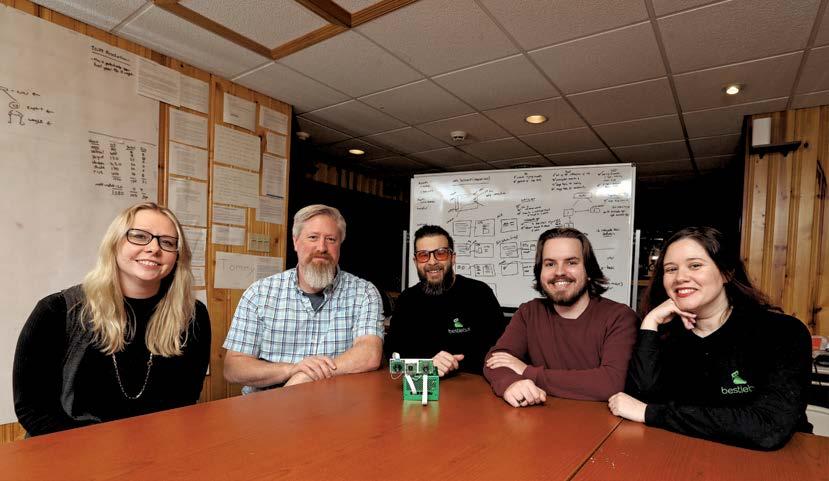
The full telehealth component is still in development, Evert says, although users currently can log into their dashboard and have their temperature taken and saved for a future caretaker visit.
To ensure privacy, all video and images are processed by AI on the camera. Only text data is sent to a hub inside the home However, users can opt to connect their devices securely to the internet, so loved ones would receive an alert with the option to dial in if a fall should occur.
“It’s almost like having someone live with a loved one,” Everts says “Eventually, we’re building a full companion AI in addition to the health monitoring. You will talk to it, and it will learn and react to you over time.”
Bestie Bot’s grant ended in February, and the company expects to have camera systems ready to install in senior living settings or private homes for pilot studies this month, he says.
Everts and Cruz say their ultimate dream is to further develop the system into an embodied agent - a sort of robot companion that would live
in the home “We’re just creating the brains of the robot right now that privately learns and responds to you,” Everts says.
While some may question replacing or augmenting human relationships with humanrobot interaction, Everts and Cruz would argue our culture has been promoting that for ages, from R2D2 and C3PO of “Star Wars” fame to Teddy Ruxpin, that animatronic child’s toy of the 1980s. Loneliness can predispose the aging to a host of health conditions, they say. If they can avoid that by finding partial companionship in an AI or robot that feels real to them, that’s what matters.
“A lot of people are really afraid about where AI is going,” Everts says “Technology is nothing by itself It’s what we do with it There’s a lot of things about AI that are going to be beneficial for society. I think we’re one of the companies showing that.”
For more information about Bestie Bot, or to inquire about participating in pilot studies, visit bestiebot.com.
26 • MARCH 3, 2024 PROGRESS LANCASTER COUNTY HEALTH
The staff of Bestie Bot, L-R Juliana Knight, Alex Barger, Richard Everts, Ben Keener, and Sugey Cruz. Missing from photo Dr. Ashton Sperry.
SPOTTING SKIN CHANGES
App fine-tuned at Lancaster innovation lab focuses on early cancer detection
DIANE M. BITTING FOR LNP | LANCASTERONLINE
The rising use of artificial intelligence has the potential to remake society, for better and worse. But one Chicago company, with ties to Lancaster, is using that powerful technology for good by helping to detect skin cancer in its early stages.
The SkinIO smartphone app allows users to take photos of their skin in 10 minutes. These images are reviewed by a dermatologist who determines whether any concerning spots merit further examination. If so, a followup appointment with a dermatologist is recommended, with guidance on finding a doctor. For repeat users, the app provides baseline photos to be compared with later photos for any suspicious skin changes.
“Your skin is your most visible organ, right? You see it every day,” says Kyoko Crawford, SkinIO’s cofounder and CEO. “You see it when you’re putting on makeup, when you’re shaving, when you’re getting dressed. But very few of us take the time to actually look.”
She adds, “SkinIO helps you look, truly look at your skin. And it’s worth your time to look at your skin because you could catch something early that could change your life.”
Lancaster pilot program
In 2022, SkinIO’s app was refined at Lancaster’s Smart Health Innovation Lab, which describes itself as a “market adoption accelerator for health care technologies.” The iLab chose SkinIO for its residency pro-
gram, which focused that year on developing innovations in tele-dermatology.
Pilot screening programs were held with several Lancaster-area employers, including Aspire Ventures and Signature Custom Cabinetry. Crawford describes those screening programs, involving a few hundred people, as “immensely helpful.”
Citing the Skin Cancer Foundation, SkinIO’s website (skinio.com) notes that 70% to 80% of melanomas appear as new spots while 20% to 30% arise from changes to existing moles. Malignant melanoma is the deadliest form of skin cancer; other forms include basal cell and squamous cell carcinomas. According to the foundation, skin cancer is the most common cancer in the United States and worldwide, and one in five Americans will develop it by age 70.
“Just tracking spots you know about is not necessarily enough,” Crawford says. “The vast majority will come from a spot that wasn’t there before, so if you don’t notice that it shows up, you may miss that early warning.”
The app uses AI and machine learning to analyze what is known as total body photography, in which as much of a patient’s skin as possible is photographed. The use of total body photography in dermatology is not new but hasn’t been widely accessible, Crawford says.
SkinIO’s technology helps a doctor spot any skin changes more easily in less time. The AI analyzes “regional images” and highlights any “outliers” that look dramatically different from
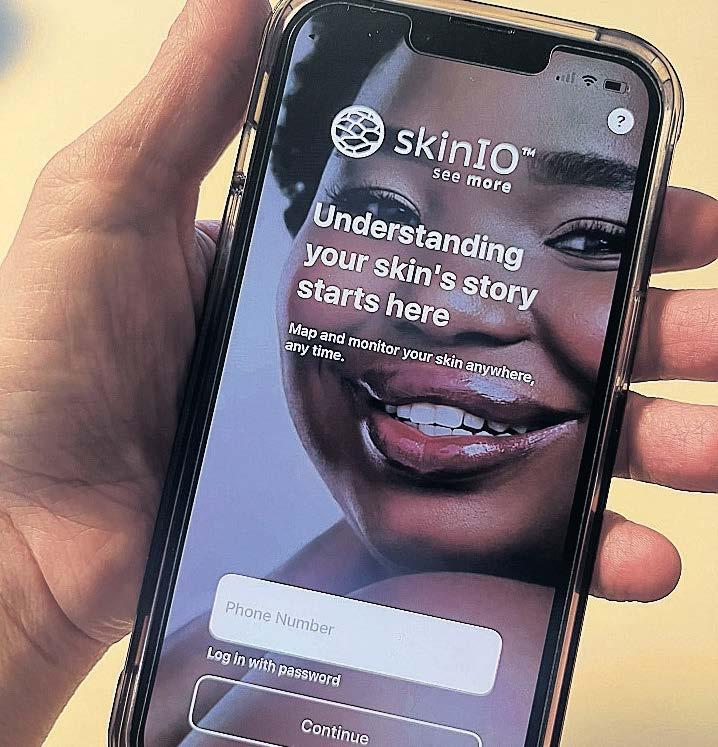
an individual’s average spots, she says.
It’s what dermatologists call the “ugly duckling model,” Crawford says. A dermatologist, who may see dozens of patients a day, is not looking at a patient’s skin “freckle by freckle, mole by mole” but rather is checking for changes to that patient’s typical pattern of skin markings.
And if someone has a lot of freckles and returns for a follow-up skin exam in a year, or three or five years, it could be difficult for even these expert specialists, who may see thousands of patients a year, to detect any potentially harmful changes, she says.
Adults should have their skin examined once a year, and those previously diagnosed with skin cancer should do so every six months, Crawford says. But wait times to see a dermatologist can be long, with what she describes as a “pretty pronounced scarcity of dermatologists in this country.”
The future of SkinIO
The SkinIO technology is not diagnostic. AI is “able to process that information really quickly, but the judgment, from the clinical expertise, the empathy, all of that should come from a human dermatologist,”
Crawford says.
The SkinIO app uses AI and machine learning to help spot skin changes that could be cause for concern.
The technology has allowed previously untapped patient populations to receive dermatological care, while compiling data from more diverse demographic groups, Crawford says. And while the use of AI in health care is “super exciting,” she says, it must be done responsibly.
Crawford started SkinIO in 2014 with Dr. JC Lapiere, a Chicago dermatologist and surgeon who cofounded the Northwestern Skin Cancer Institute. Lapiere had saved the life of Crawford’s father-in-law from melanoma — twice.
Crawford, with a background in biomedical engineering, had founded and ran a New York City-based technology development consultancy before launching SkinIO.
SkinIO, which uses a network of dermatologists licensed in 35 states, is not currently marketed to the general public. Instead, it’s mainly available as a health care benefit through an employer or union, Crawford says. So, while the app can be found on GooglePlay and the App Store, an organization code is needed to access it.
However, possible development as a direct-to-consumer product is “certainly on the roadmap,” she says.
MARCH 3, 2024 • 27 PROGRESS LANCASTER COUNTY HEALTH
STAFF
Monitoring
Continued from 24
the staff shortage experienced by all health care systems today,” LaCoe says.
The AI-generated technology will also soon be put into operation at Penn State Health Holy Spirit Medical Center, Camp Hill, and Penn State Health Hamden Medical Center, Enola.
‘A game-changer’
Penn Medicine Lancaster General Health uses AI-driven technology to optimize patient care by continually monitoring patients’ health and providing real-time data to providers.
The Phillips Healthcare Smart Alert technology tele-ICU program is in a centralized location for nurses and providers to extend monitoring
of ICU beds by using sophisticated alarming algorithms with multiple data sources to help alert clinicians when something happens.
Monitoring is done through a multidisciplinary team of health care professionals. Once alerted, the team contacts the attending physician if needed.
“Penn Medicine is using Rapid AI in emergency rooms,” says Michele Sellers, director of the NeuroRescue Program at Penn Medicine, University of Pennsylvania Health System.
The program, developed by a San Mateo, California, company, uses an AI-based platform designed to identify patients who could benefit from brain-saving procedures.
The sophisticated software tool helps physicians identify more accurate diagnosis for faster care.
“It’s a game-changer for stroke care,” Sellers says, explaining the program can interpret CT scans
within minutes, speeding emergency care for the patient.
The technology tool speeds up assessment and care for stroke patients when time is critical.
Penn Medicine has been using the program for the past five years with significant success at all five hospitals in the Penn Medicine Health System: Lancaster General Health, Chester County Hospital, West Chester; and Pennsylvania Hospital, Hospital of the University of Pennsylvania and Penn Presbyterian Medical Center, all in Philadelphia.
“We believe AI will change health care significantly over time, touching all areas of the service delivery model,” says Allen Cubell, Penn Medicine Lancaster General Health’s executive director of innovation, Center for Health Care Innovation.
Cubell says LG Health is continually exploring new systems to improve quality and safety for patients.
Improving efficiency

The UPMC health care system is using AI technologies to increase efficiency of health care practices.
Chris Camody, UPMC chief tech-
Imaging
Continued from 25
the team faster access to the patient’s scans/images.”
Cross says Lancaster General Health is exploring mammography systems that would improve breast cancer screening. Penn Medicine researchers have developed an AI tool/ imaging technique that’s still being tested that provides highly detailed views of cells and how patients’ genes operate, allowing doctors and researchers to see cancer cells that may have been virtually invisible.
Proceeding with care
Chris
Carmody,
senior vice presi-
nology officer, explains the health care system isn’t quite there yet to use AI for patient monitoring.
“We’re taking a very thoughtful approach to ensure the integrity, reliability, security and privacy of patients is first in place,” Camody says.
He says he sees tremendous value in the AI technology currently in use at UPMC for documentation and predictive analysis, noting it saves time for clinicians.
The technology proved to be especially helpful in addressing pandemic-related challenges that impacted efficiencies, he says.
Camody agrees the technology is getting smarter and can help with staff shortages and contribute to better patient outcomes.
Before UPMC puts AI technology in place to monitor patients, the process will undergo rigorous due diligence, he says.
“It’s unlikely AI will replace a clinical staff, but could become a care team copilot to alert them to take action,” Camody says. “And (it) will make us more effective in care and treatment.”
It’s a goal, he says, we all want for our patients.
dent of the UPMC information technology division, says AI is currently used in the ophthalmology department to evaluate images of the retina to look for signs of macular degeneration. For patients with acute stroke symptoms, UPMC uses AI to review CT scans and flag areas for a radiologist to examine closer.
Moving forward, AI will be used in other areas, he says.
“We’re on this journey, and we’re diligent in our testing and evaluation of this technology,” Carmody says. “We want to be sure it meets the high standards we’re looking for. In evaluating the various AI imaging packages, we’re also concerned with the cybersecurity of our patient’s data. We continually evolve our practices to protect our patient’s data.”
28 • MARCH 3, 2024 PROGRESS LANCASTER COUNTY HEALTH Caring for Our Community
1980 Providing personalized care and comfor t to help patients and families live better with serious illness. www.hospicecommunity.org (717) 295-3900 A program of Choices Healthcare
Since
HOME


MARCH 3, 2024 • 29 PROGRESS LANCASTER COUNTY
PAGE 30 JENNY FOSTER | FOR THADDEUS STEVENS COLLEGE OF TECHNOLOGY
Mitch Kauffman, front, an instructor in the Civil Engineering Construction Technology program at Thaddeus Stevens College of Technology, says his students are excited to see how AI is impacting the fields of design and construction.
AI AND CONSTRUCTION: ‘CAN THESE BUILDINGS DESIGN THEMSELVES?’
REBECCA LOGAN FOR LNP | LANCASTERONLINE
A man in a hard hat stands on some scaffolding and bemoans how he’s forgotten his tools. He whips out a touch screen and a robot below springs into action.
The robot and the YouTube clip it stars in come from Boston Dynamics — the same company featured in a 2022 Super Bowl ad in which security guards dance and drink Sam Adams with robots. In this more practical 2023 clip, a robot picks up a wooden plank and fashions it into a bridge before scampering up the scaffolding, tossing the man his tool bag and sticking a flashy tuck-androll dismount.
What’s longtime construction project manager Mitch Kauffman think when he watches that clip?
“I think I need to retire,” he says. He’s joking. Kind of.
Kauffman joined the faculty of the Civil Engineering Construction Technology program at Thaddeus Stevens in late 2022, after working in the industry for more than 25 years. He knows that artificial intelligence is already impacting the fields of design and construction and will have transformed that world by the time most of his students are his age.
They’re excited, he says.
“When I bring the (construction equipment) manufacturers in and they talk to them about what’s coming down the pike, they look at that screen and they basically see a video game,” he says.
That piques their interest, he adds.
“I think that’s also why you get pushback from people my age,” he says. “People 50-plus who didn’t have that 30 years ago and think, ‘Why do I need that?’ I think that’s where a lot of the trades are still at.”
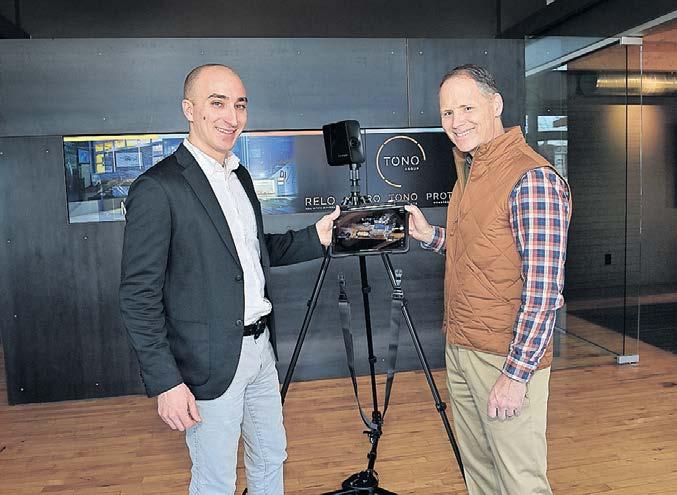

There are exceptions. All the big equipment manufacturers for heavy and highway construction are integrating machine control, he says. That’s increasingly GPS driven.
“A guy doesn’t have to look out at a survey stake on a road project,” he says. “He’s able to look at the screen and know that he’s 2 inches high, 2 feet low, and the machine will do its own thing, basically. That’s a huge advance.”
However, Kauffman says AI’s impact in construction is still largely in the office setting — used for things like cost estimation.
“It’s not the dirty hands, except the
machine-controlled equipment,” he says. “But it’s coming.”
AI and design
It’s already here, says Hunter Johnson, CEO of the TONO Group, an architecture design firm founded in Lancaster in 2001, pulling its name from the word “autonomous.” Sure, advances like ChatGPT have put AI squarely in the public sphere. But more primitive, behind-the-scenes AI has been part of the design landscape for some time, Johnson says. A few months ago, his firm purchased a Matterport Pro3 3D camera
and digital mapping system, which he says includes elements of AI. One person takes that to a building, moves it to different positions, and within a matter of hours that building is measured and those measurements have been turned into a seamless contiguous field. The same job in the past may have taken two or three people two days, Johnson says.
“We were even joking yesterday … saying, ‘What if we could make it like one of those Giant food store robots that have those eyeballs?” Johnson says. “You put this thing on it, you send it into the building and it comes out the other end like two hours later. Done. It’s kind of creepy almost.”
Software plug-ins are coming fast, allowing folks to populate background imagery and pull in a variety of options that help architects make decisions with their designs, he says.
“I think the next step that everybody’s kind of concerned about is, ‘Can these buildings design themselves?’ ” Johnson says. “Can you really just put a bunch of parameters into the software, kind of like you can if you’re composing … an advertisement, and say, ‘I want a home with four bedrooms, and two bathrooms and a garage and it should be of this style’? … We’re not there. But we’re not far from that.”
It does give him pause.
“One of the terms we use is that we try to elevate architecture or buildings to give them a soul,” Johnson says. “We call it creating meaningful places.
“Granted, not every piece of architecture is going to be sacred or impact someone at some deep level. But we at least aspire to that,” he adds. “How does a machine figure that out? How does it aspire to infuse BUILDING, page 31
30 • MARCH 3, 2024 PROGRESS LANCASTER COUNTY HOME
Drew Hohenwarter, left, architect, and Hunter Johnson, CEO, both of TONO Group in Lancaster, stand with a Matterport Pro 3 camera. The camera can provide measurements, drawings and floor plans for a room or building, and create a 3D rendering for virtual tours. The tablet, at left, shows a partially scanned building.
SUZETTE WENGER | STAFF PHOTOGRAPHER PHOTOS
Building
Continued from 30
something that is unique or personal to the actual inhabitants? … That’s the big question for me.”
At least on one hand.
“Ultimately, even though I talk about these high-level, almost spiritual thoughts about architecture and what we try to do, it’s still a business,” he says. “And it’s a business that’s getting more and more competitive all the time.”
So gravitating to a competitive advantage makes sense, he says, adding that AI upsides range from speeding the process to reducing risk.
“If it can do these things … that’s where you have to bring it into your toolbox,” he says. “It’s no different from going from a paper medium to a digital medium back in the ’80s. You didn’t have a choice unless you wanted to be a dinosaur and basically go extinct.”
Be prepared
Tim Austin agrees.
He’s an architect with ColabXYZ, which has offices in Lititz and Milan, Italy.
“A lot of the (social media) accounts that people are following in the architecture community are saying, ‘Hey, look. I did this. It’s a new sketch. It’s a new idea. And by the way, here’s my prompt,’ ” he says. “Because there’s this idea that we’re all sort of learning how to become prompt writers together.”
Austin says much of what AI is currently doing for architects he would equate to parlor tricks.
“That’s not really the extent to where this technology is going to take us. We’re very much at the beginning,” he says. “But I think it’s also wise for folks to inform themselves about it and start to prepare themselves for that wave.”
Artificial intelligence will change the concept of authorship, Austin says. Take the architects who have
been entirely focused on renderings.
“They would hand that off to some engineer or subcontractor to build their beautiful, shiny tower on a hill,” he says. “It’s sort of democratized now.”
Anyone can create something beautiful, he says, adding architectural success will now take more.
Many of his friends from Cornell University, where he graduated in 2010, plus the advanced program he completed in Italy are immersed in AI jobs and startups. Austin is soaking up what they say as well as what he hears in interviews from the biggest players in the AI game.
“With so many technologies, the people who know them the best are the most optimistic about them because they see all those upsides,” he says. “In this case? The people who know the technology best are freaked out. There’s no getting around that. Anyone who’s fully informed about AI is having an existential crisis right now.”
Kauffman admits he finds it all a bit frightening. He thinks about how even machine-controlled equipment is only as good as satellite reception, which can be rough on bad weather days or if used close to tall buildings.
“There are still limitations to a lot of this stuff,” he says. “Is that stopping people from implementing it? Not at all.”
What the future holds
In another example from Boston, a 125-year-old scaffolding company doing work on a major renovation of the city’s former public schools headquarters last year used two semi-autonomous robots called Liftbots. They bought the robots after the CEO of the German company that makes them was in town for a robotics conference and stopped by the scaffolding yard with a demo, per a 2023 Boston Globe article.
Then there’s the TyBot from Advanced Construction Robotics, a Pittsburgh-based company which says its rebar-tying creation can

self-locate, self-position and selftie more than 1,200 intersections per hour, day or night, rain or shine. Its webpage lists several past projects — many of them massive bridge decks — the closest to Lancaster County being the Susquehanna Valley Transportation River Bridge in Union County.
Kauffman has shown his students videos of rebar-tying robots.
“How far is that out from where
we’re at locally? Probably miles,” Kauffman says. “We’re not anywhere near that, that I’m seeing or hearing.”
At least for now.
“It’s crazy where we’ve been. It’s crazy where we’re going,” Kauffman says. “I mean, in my industry we still dig up wooden water lines. And now there are robots that are able to pick tools up and carry them to somebody. Where do we go now? I just don’t know.”





MARCH 3, 2024 • 31 PROGRESS LANCASTER COUNTY HOME
Instructor Mitch Kauffman, left, works with students from Thaddeus Stevens College of Technology.
JENNY FOSTER | FOR THADDEUS STEVENS COLLEGE OF TECHNOLOGY
705 OLDE HICKORY ROAD | LANCASTER, PA | 717-560-9733
Molly Lueke, Becky Goodman, Andrew Porter, Lynda Evans, Karyn Miller, Ann Hinkle, Zach Miller, Luke Mosch
‘IT’S HELPING US MOVE FORWARD IN LEAPS AND BOUNDS’
From creating visualizations to analyzing data, artificial intelligence is a growing tool for those interested in buying, selling, investing in real estate
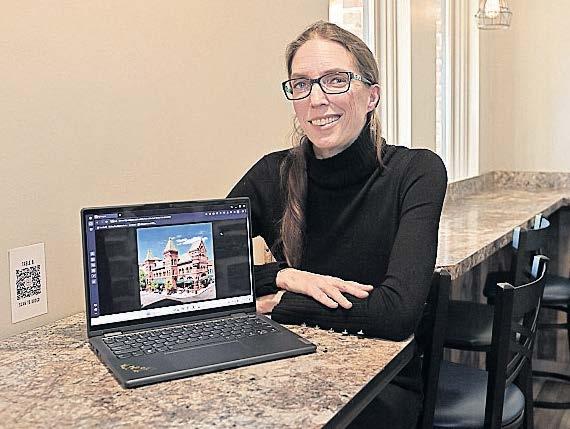 CHAD UMBLE
CUMBLE@LNPNEWS.COM
CHAD UMBLE
CUMBLE@LNPNEWS.COM
What would that house be like with a sunroom in the back? What would that bathroom look like with a black-and-white tile floor? How much should insurance cost on a three-bedroom home in Mount Joy Borough? What is the best real estate investment right now in Lancaster County?
For real estate professionals, investors and homebuyers, those are just some of the questions that artificial intelligence tools can answer — or could possibly answer in the future — about buying, selling and owning properties.
“Right now there’s so many tools that are coming out for real estate every day that you can leverage for so many different tasks in real estate. It’s helping us move forward in leaps and bounds,” says Chandra Mast, owner of Ephrata Borough-based Red Rose Appraisals, who has taught courses on AI for the Lancaster County Association of Realtors.
Real estate is particularly ripe for the application of AI tools, Mast says, since artificial intelligence tools do a good job of creating visualizations while also effectively syn-
thesizing and identifying patterns in data to predict potential investment returns or provide accurate home prices.
“Data and the visualization are big parts of real estate, and they are also in AI,” Mast says.
Mast makes extensive use of AI tools for her own business, including to summarize sales data in different markets, glean relevant zoning regulations for a specific property, and create social media posts that include AI-generated images inspired by local architecture.
For real estate agents looking to bolster their social media presence as they create a trusted brand, the tools can be valuable time-savers, Mast says.
Among the tools Mast recommends for real estate agents are ChatGPT and Perplexity for research, MidJourney and DALL-E for images and Listingai and Epique for marketing.
“There’s a lot of one-trick ponies. Right now, it’s about stacking all these one-trick ponies up to get what your needs are,” she says. “I have a series of eight or nine one-trick ponies as a general appraiser to get the job done.”
One customer-facing tool is the “redesign” function incorporated into Redfin’s sale listings that allows shoppers to virtually change the flooring type, wall color and other elements in pictures of listings. While AI tools can give buyers and sellers a lot of their own information, Mast says local agents still play an important role if they understand how to put everything in its proper context.
“You can get a certain level of information, but it is going to take a local understanding to put together the local nuances of what that means
to our community,” Mast says. “And hopefully that is what the local agent is going to bring to the table.”
An approach to investing
For real estate investors, AI offers the possibility of getting a deeper understanding of local markets since it can synthesize reams of data about sales, average rents, incomes and insurance rates, among other things. Some tools could also help with property management, including by automating communication with tenants.
Lancaster-based real estate investor Chad Gallagher says new AI tools are the latest application of using technology to make better decisions in real estate. Along with business partner Nate Jones, Gallagher owns some 200 properties, including single-family homes, commercial units and apartment buildings.
“Everything we do in real estate is to figure out where we can utilize math or tech to do things differently, either to provide service for investors or help us to invest smarter for ourselves,” Gallagher says.
In 2013, Gallagher and Jones began
32 • MARCH 3, 2024 PROGRESS LANCASTER COUNTY HOME
Chandra Mast, owner of Red Rose Appraisals, displays an AIgenerated image of Lancaster Central Market. Mast teaches local Realtors how to use artificial intelligence in their businesses.
REAL ESTATE, page 33
SUZETTE WENGER | STAFF PHOTOGRAPHER
Real estate
Continued from 32
SlateHouse Group, a property management company that was sold in 2022 to Home365, an Israeli-based technology-focused real estate company. Now, Gallagher and Jones work on their own investment projects while operating Real Estate Hackers, which offers free programs and networking to real estate investors.
While Gallagher says the mania for AI has led to many simple technology solutions being labeled as “AI,” there are nevertheless some tools that could revolutionize the industry.
One AI function Gallagher is testing for rental units is a chat function that can both respond to tenant questions as well as engage them in a conversation about their needs or concerns. An AI-powered chatbot could be effective, Gallagher says, since tenants
typically ask only a couple of variations of questions about repairs, rent payments or moving in and out, all of which have prescribed answers.
“There’s 30 questions that get asked over and over again,” he says.
Using AI as a chatbot is a step up from many systems that currently accept inquiries but then only give a canned response that must be followed up on by a person.
“Now, where we see things going is AI being smart enough to understand what was said back and actually be able to respond with something intelligent, and how we want it to speak back to a tenant,” he says.
Investing wisely
AI tools also do a good job of suggesting rental rates for specific apartments as well as determining property values since they can analyze such publicly available data.
“A good valuation for a property is a perfect tool for AI. It is just ingesting data and spitting out what it thinks is the best estimate,” Gallagher said.
From getting a proper valuation, AI tools could then create a profit and loss projection for a property, although Gallagher says an investor could potentially take it one step further.
“Now, you can imagine the next step is being able to look at all properties across everything available in Lancaster County and ask, ‘Given your analysis, what is the best investment to make based on a high internal rate of return, given the listing price on every property?’ ” Gallagher said.
Of course, a bidding war could result if everyone discovered this theoretical best investment, thereby driving up the price and making it no longer the best investment. But Gallagher says most investors aren’t taking advantage of all the tools for understanding the markets, provid-
ing opportunities for anyone who is.
“What you’re going to see over the next couple years is that the folks who are using AI the fastest and adopting AI the fastest, they are going to win in most industries, and for sure in real estate,” he said.
As more real estate investors use AI tools to make investment decisions and manage their properties, it can lead to fewer costly mistakes, creating more certainty about what a real estate investment is actually worth. And when investors have more confidence in any asset’s value, it typically goes up.
“The emotional toll is what hurts a lot of investors. Part of (using AI tools) is trying to take the emotion out of it and look at the whole picture and understand what is going on,” he said. “The (real estate) game is full of mistakes and that is what really speaks to AI. You can today make all these mistakes and still make a lot of money.”










































MARCH 3, 2024 • 33 PROGRESS LANCASTER COUNTY HOME
MEET LANCASTER COUNTY’S 464 North George Street, Millersville, PA 17551 Member LCAR, MLS thabecker@yahoo.com HabeckerRealEstate.com Bus:717.872.5407 Cell: 717.940.8379 Fax: 717.872.5416 M. Todd Habecker BROKER Anne M. Lusk , Realtor 100 FoxshireDrive | Lancaster,PA17601 AnneLusk.com | 717-291-9101 WhereExcellence Meets Experience! Representing homes at ever yprice range Kim Sutter Eckels Realtor® Office: 717-533-2500 Cell:717-575-8289 kimsuttereckels@gmail.co https://kimsuttereckels.kw fice: Andy Esbenshade O: 717-295-HOME D: 717-615-4874 aesbenshade@homesale .com www.thelancastrian.com Team@TeamTrimble.com www.TeamTrimble.com CAROLE KIRCHNER REALTOR® Office •7 17-560-9100 Cell •7 17-629-8498 Carole@caroleschoicehomes.com www.caroleschoicehomes.com Amember of the franchise system of BHH Affiliates,LLC R ealtors! R ealtors!
WONDERING WHAT TO PLANT?

We put 2 artificial intelligence garden planners to the test to find out how well they really work
An open backyard is like a blank canvas.
But for some prospective home gardeners, it can be intimidating to know where to start.
As artificial intelligence becomes ubiquitous, even matters of nature aren’t off-limits from this technology’s power. Some developers have created AI garden planners to help gardeners decide what, and how, to
plant. But how well do they work?
To find out, we put two AI garden planners to the test, and then asked LNP | LancasterOnline’s Master Gardener columnist Lois Miklas to review them. Here’s what the planners suggested, and what Miklas liked (and didn’t like) about each option.
THE BASIC OPTION: CHATGPT
n Description: This is the AI you’ve likely heard of, whether from your grandkids talking about having a conversation with a robot online, or from funny folks on Twitter giving outlandish prompts for screenplays. It’s also free, hence its popularity. We gave ChatGPT this prompt: “Plan a small garden for a beginner in Hardiness Zone 7a,” the hardiness zone that encompasses most of Lancaster County. It replied with an answer instantly.
ChatGPT suggested 14 different specific varieties of plants and their benefits. It suggested placing taller plants at the back and shorter ones toward the front; grouping plants with similar water and sunlight requirements; and watering consistently. It also suggested adding a small decorative element, like a garden gnome.
A MASTER GARDENER’S OPINION
n What it got right: I like the fact that this plan suggested a variety of plants: vegetables, perennials, herbs and shrubs. It gave the gardener a lot to choose from and suggested plants that are commonly available and easy to research. It included botanical names for the perennials, eliminating the confusion that can be caused by looking up a plant by its common name. Its suggestion to consult a gardening book or an online resource for garden planning is essential, considering that this plan is so openended. I experimented further, and when ChatGPT was asked for garden planning books and website recommendations, it returned a fairly useful list.
n What still needs work: I was amused by the plot that ChatGPT proposed for the beginning gardener, an 8-by8-foot, mostly sunny space. Who has a perfectly square garden space ready to plant? (Well, perhaps if you rent space in a community garden.) I would have started by suggesting that the gardener measure the space that they want to plant, observe the amount of sunlight it gets and conduct a soil test. At this time, it seems beyond ChatGPT to include links to each recommended plant so that one could see a photo and read about height and spacing requirements and common problems.
n Final ruling: One could not really act on ChatGPT’s garden plan, given the fact that it is so vague. To receive any useful garden planning advice from ChatGPT, I suggest being as specific as possible with your prompt, perhaps even asking for suggestions for a GARDEN, page 35
34 • MARCH 3, 2024 PROGRESS LANCASTER COUNTY HOME
ANGEL LUCIANO | STAFF GRAPHIC
Garden
Continued from 34
specific type of garden. Be cautious: When experimenting, I noticed that ChatGPT readily recommended plants that are on Pennsylvania’s invasive plant list unless it was specifically asked for native plants.
ADVANCED OPTION: AIGARDENPLANNER.COM
n Description: For those looking for more involved direction, AIGardenPlanner claims to offer “detailed, personalized plans and professional advice tailored to your garden’s unique conditions.” Unlike ChatGPT, which asked no questions, AIGardenPlanner asked for lots of specifics, including gardening experience, budget, and if the gardener has any allergies. It also required specific measurements for raised garden beds, ground space and soil type. With Miklas’s input, we asked the software
to create a planner for a 36-by-72-inch raised bed with loam soil type and a 48-by-120-inch ground space with primarily clay soil.
The prompt costs $4.99, and a link is emailed to the user after purchase, which the site estimates to take 30 minutes. We did not receive the link promptly, but a customer service representative was friendly and helped to properly deliver it.
Not only did it list plant recommendations, but expanded on specific varieties’ compatibility with other plants, when to prune, which pests they are susceptible to and more.
A MASTER GARDENER’S OPINION
n What it got right: AIGardenPlanner returned a recommendation of five plants for each bed. A drop-down menu and sidebar included more information for each, such as why the plant was recommended, how to plant, growth habits, spacing, fertilizer, pruning, pest management and maintenance tips. The information was concisely presented with a photo of the plant and appealing graphics.
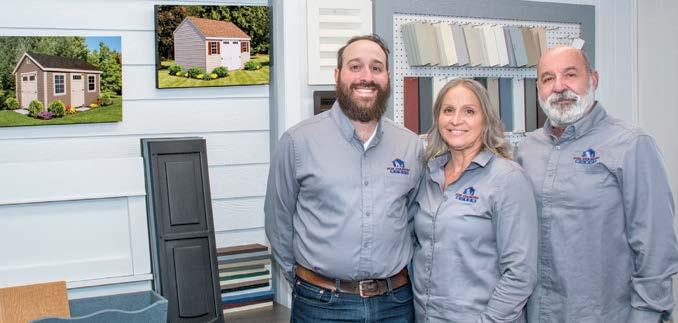
Fox Co un try Sheds ow ners Jeannie and Ad am Ko nt is , and their so n Al ex ander, we lc ome yo u to st op by their sa les of fic e.

For over 25 years, Fox Country Sheds, owned by the Kontis family since 2008, has been a trusted name in crafting top-quality, handcrafted sheds and prefabricated garages Explore their 3D Design Customizer and Augmented Reality feature for a personalized shed design experience. Imagine “viewing” your Poolhouse Shed design virtually in your backyard, before placing your order.
While each shed is handcrafted in their local carpentry shop, Fox Country Sheds prioritizes current innovation and design trends to provide valuable storage solutions. Visit their manufacturing facility and sales lot to explore shed styles and options, or customize your design online in 3D from their website.

2023
n What still needs work: I did not expect AIGardenPlanner to recommend almost the same slate of plants for each bed: basil, lettuce, marigolds and cherry tomatoes, with the addition of sunflowers for the raised bed and zinnias substituted for sunflowers in the long, narrow, in-ground bed. Though LNP stated its gardening goal as “food, beauty, wildlife,” the planner leaned heavily toward edibles. Surprisingly, it estimated the monetary value of each vegetable or flower when harvested, something that home gardeners are not usually concerned with. It also included a few sentences on each plant’s compatibility with other plants. I felt that much of this information was based on popular lore about companion plants, not science, and was unhelpful and misleading.
n Final ruling: AIGardenPlanner asked for quite a few details from the user, which is itself useful in getting the gardener to think through their goals and garden situation. A beginner could probably use the information from AIGardenPlanner to start a garden, but with a little tweaking from its designers, it
could be much more useful by recommending specific varieties of each plant or suggesting a succession garden plan. For example, lettuce is a spring and fall crop that could be planted before or after some of the other plants on the list, but this was not mentioned. Finally, I was surprised by the lack of recommendations for perennials or shrubs, which are often the backbone of an in-ground garden. It would be interesting to experiment with this planner by listing wildlife or beauty as the first of the list of goals to see how the recommendations might change.
A MASTER GARDENER’S CONCLUSION
AI garden planning still has a lot to learn, but with so much information available, I would not be surprised if this quickly becomes a powerful tool for gardeners, especially beginners. For now, being as specific as possible with prompts is probably the best way to make this technology useful.
2023



537 E. 28th Division Hwy., Lititz 717-626-9560
info@foxsheds.com
Customize your shed: www.foxsheds.com
MARCH 3, 2024 • 35 PROGRESS LANCASTER COUNTY HOME
RESIDENTIAL • COMMERCIAL Landscape Architect & Arborist
Th an k yo u to al l ou r cu st om er s, em pl oy ee s an d st af f!











MILK • DRINKS • ICE CREAM • EGGS







Family owned and operated since 1935, Kreider Farms is a fourth-generation farm that is dedicated to local agriculture and land preservation practices.

See our farm in action for yourself! Experience the sights, smells and sounds of a real dairy farm on the Kreider Farms Farm Tour, where fun meets farming in an unforgettable adventure!
36 • MARCH 3, 2024 PROGRESS LANCASTER COUNTY ENVIRONMENT



MARCH 3, 2024 • 37 PROGRESS LANCASTER COUNTY
BY
ENVIRONMENT SPONSORED
PAGE 38 ANDY BLACKBURN | STAFF PHOTOGRAPHER
A fisherman removes the hook before releasing trout on opening day of trout fishing along the Little Beaver Creek in Strasburg Township last spring. A new app uses AI to track an individual fish from one catch to the next.
FOLLOWING THE FISH
Free TroutSpotter app uses artificial intelligence to help spot trends in coldwater fish populations
ELIZABETH DEORNELLAS EDEORNELLAS@LNPNEWS.COM
Improvement in local streamwater quality is expected to be among the benefits as artificial intelligence drives an app that will make anglers’ photos about much more than bragging rights.
The free TroutSpotter app that identifies and tracks individual fish will launch in the spring through the Trout Unlimited website — tu.org — and will allow the national nonprofit to put its thousands of members to work helping researchers spot trends in coldwater fish populations.
Katie Bartling, the watershed project coordinator at Penn State’s Agriculture and Environment Center, says she’s optimistic that TroutSpotter will provide a deeper connection to nature that will make anglers more curious about their local streams and more attentive to the ecological conditions that make their favorite spots ideal for fish.
“When you start to look at one individual, then you start to build that story of why that individual likes that spot,” Bartling says, “you start to get a broader, wider perspective.”
Individual anglers will only see their own data, in order to protect the privacy of favorite fishing spots, but researchers will have access to the entire database so they can analyze how particular species are faring in various stretches of water.
As an added bonus, participating anglers will receive a notification when a fish they photographed is spotted again.
“They get a notification saying, ‘Hey, you know, we found George,’ ” says Nathaniel Hitt, a research fish
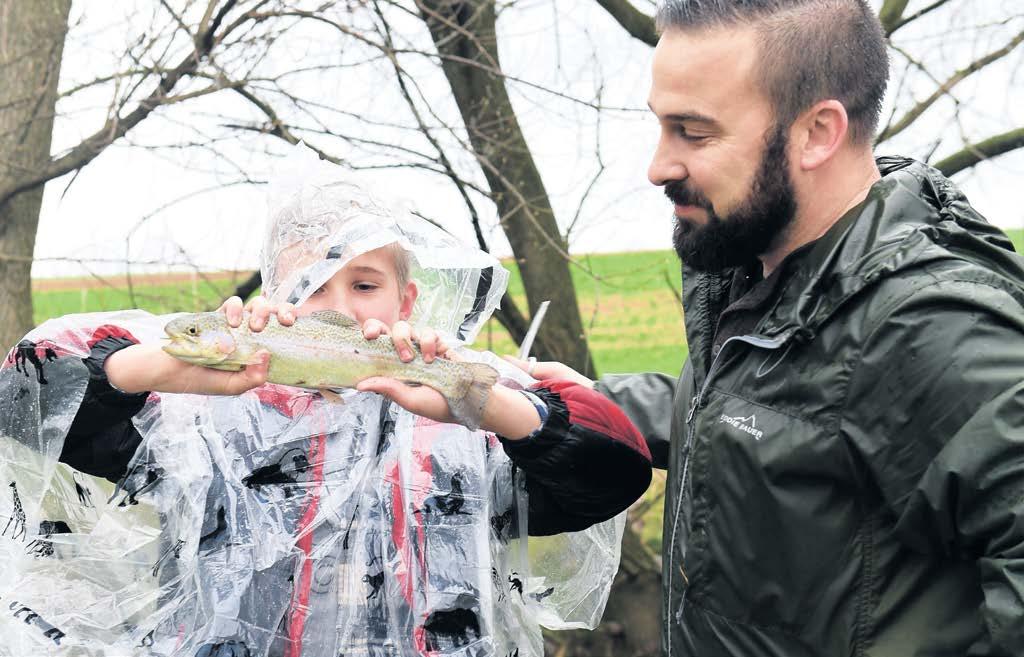
Grant Dressler shows off his catch on the first day of trout season last year along Big Beaver Creek in Strasburg Township, with father Bob Dressler looking on. A new app can capture a trout’s unique spot patterns and identify the fish with 90% accuracy when it is caught again.
biologist at the U.S. Geological Survey’s Eastern Ecological Science Center in West Virginia.
Hitt says he hopes the social aspect of using uploaded photos to track the movements of individual fish will further invest anglers in the health of their local waterways.
TroutSpotter will be a useful tool for anglers of all ages, but Hitt says it has the potential to engage younger fishers who are more interested in technology.
Collaboration builds capacity
The app and the research it will support are a collaboration between the U.S. Geological Survey, Trout
Unlimited and Wild Me, a nonprofit that builds the software tools needed to track individual animals through photography and AI-powered computer vision.
There are apps on the market already that can identify animals by species, such as FishVerify or the bird identification app Merlin, but TroutSpotter is a more precise tool.
The app is built off a neural network that is trained to recognize the unique spot patterns on fish such as trout and salmon.
“What we’re doing is pushing the boundaries there and taking things to the individual level,” Hitt says.
To enable that process, images are digitally sliced into ribbons and then pixels and fed into the model square
by square so that the neural network can identify the red, green and blue color values that make up the markings on each individual fish.
Hitt says researchers have found the tool performs at above 90% accuracy identifying fish caught across different seasons and years.
“The technological capacity is there,” Hitt says.
The main focus in the eastern regions of the country will be inland trout: brook, brown and rainbow.
Hitt says it’s still an open question whether the technology will work for other species, such as smallmouth bass, but he says the technique should work for any fish with spot patterns. Trout have a spot pattern
38 • MARCH 3, 2024 PROGRESS LANCASTER COUNTY ENVIRONMENT
ANDY BLACKBURN | STAFF PHOTOGRAPHER
FISH, page 39
Fish
Continued from 38
as unique as a fingerprint.
Fueling local conservation efforts
Bartling says the app could be helpful to monitor fisheries for native brook trout.
That species has a narrow temperature window it tolerates, with temperatures above 68 degrees considered stressful for the fish.
Of the wild trout waters identified by the Pennsylvania Department of Environmental Protection, Bartling counted 38 in Lancaster County. She says monitoring those streams could help Trout Unlimited better target its conservation efforts.
As a Trout Unlimited member and a fly angler herself, Bartling says she appreciates all the organization has done to implement stream cleanups and other water-quality projects, and she says TroutSpotter data would prove valuable even if it were only used to better inform the prioritization tools the nonprofit already uses to help select projects.
Bartling says the ultimate impact of the TroutSpotter data could depend on how many of the conservation organizations working to improve Lancaster County’s water quality have access to the data.
But Bartling acknowledges that
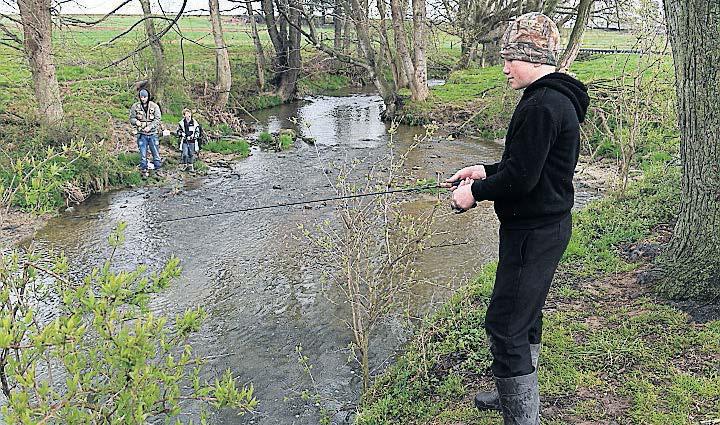
up their location.”
Slater says it might take a couple of seasons, or even a couple of years, for anglers to start seeing the benefit of using TroutSpotter.
“I think it could probably work,” Slater says. “But you’re really going to have to sell it.”
data access could prove complicated — anglers don’t want to expose their favorite locations, and conservationists would also prefer those sweet spots remain isolated to avoid putting pressure on the habitat.
Trout Unlimited’s Donegal chapter places a strong emphasis on conservation, and its 800 members have become an active force in Lancaster County’s water cleanup efforts.
Privacy vs public data
Donegal Trout Unlimited membership coordinator Gary Slater says as motivated as the members are to expand conservation efforts, TroutSpotter could be a tough sell if anglers feel the steps taken to anonymize their data are not enough.
Slater says the balance between privacy and data access presents a catch-22: If individual anglers could see the location where a particular fish they caught had been caught again, that would provide useful information that could motivate anglers to use the app; however, providing that information would mean exposing fishing locations, and giving up location data could deter app users.
In other words, any steps taken to increase the data on migratory patterns that individual users can access could compromise the privacy controls designed to encourage app participation.
“Yes, it would be great to know whether these fish have been caught again,” Slater says. “But, at the same point in time, nobody wants to give




Bartling says there are potential solutions to the tricky balance between public access to data and protecting anglers’ privacy: For instance, she says researchers could break down streams into runs of 200 to 500 meters to make any released location data less exact or they could identify a select group of public access fishing spots as pilot studies and release the data from those locations to show what the app can do.
Trout Unlimited senior scientist
Helen Neville says rolling the app out slowly and focusing on a few target locations in the first year will allow Trout Unlimited staff to work out the kinks and ensure the app holds value for both anglers and scientists.
Neville says the ideal situation is to identify locations where app data could be useful to an ongoing research study, so that participating anglers in a specific place are in close touch with scientists and understand what question their data will help answer.
For example, Neville says TroutSpotter data could help identify whether or not fish are using a restored migratory corridor or track population numbers in a habitat area that’s undergone conservation work.
MARCH 3, 2024 • 39 PROGRESS LANCASTER COUNTY ENVIRONMENT
ANDY BLACKBURN | STAFF PHOTOGRAPHER
Leroy Stoltzfus fishes on opening day of trout season last year in Strasburg Township.
www .NextT oNewFin eFu rn it ur e.com 573 Willow Rd. Lanc., PA 17601 • 717.615.9386 NEW HOURS Open Tu esday th r ough Sa tu rday 10am-5pm • Gold • Silver • Sterling Flatware • Jewelr y • Coins • Pocket Watches • Antique Guns • Quilts • Old Toys • Advertising Signs • Vintage Wristwatches • Collectible Coins & Paper Money Antiques & Mid-Centur y Items BUYING & APPRAISING IN STORE OR HOME VISIT Please make appointment with staff. 2022 NEXT TO NEW ALSO PURCHASES ESTATES WITH CLEAN OUTS. Schedule appointment with staff. Ep hr at a • La nc as te r • Wi llo w St re et • Appellate Adovcacy • Consumer Law • Criminal Law • Dog Bites • Education Law • Elder Law • Family Law • Medical Marijuana • Personal Injury • Social Security • Wills & Estate Planning • Workers’ Compensation 717.299.7342 PyferReese.com PYFER REESE STRAUB GRAY & FARHAT PC 2023

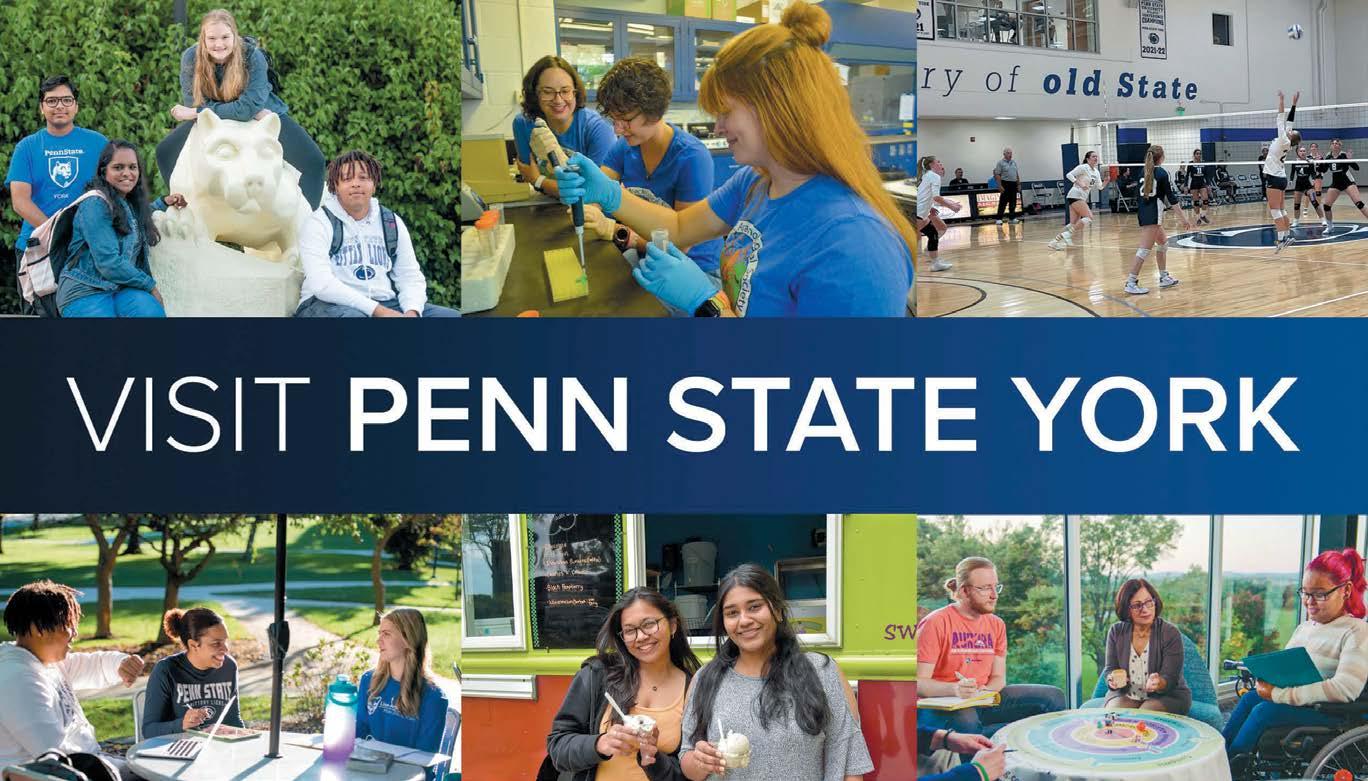

-Penn
-Graham
-Convenient
-York Launch Box
-


40 • MARCH 3, 2024 PROGRESS LANCASTER COUNTY
State degrees and certificate programs
Fellows Program for Entrepreneurial Leadership
ARN ABOUT:
Center for Inclusive LE
-Opportunities for adult learners
classes
clubs
Leadership
PENN STATE YORK
sports
(M)
-Student
and organizations
DISCOVER
-Collegiate
Baseball
W)
Basketball (M,
W)
Golf (M,
Soccer (M)
STATE YORK 1031 Edgecomb Avenue York, PA 17403-3326 717-771- 4040
book.com/pennstateyork
york.psu.edu Penn State York
OPEN HOUSE
April 6 10:00 a.m. to 1:30 p.m. PLAN TO SCHEDULE A VISIT! Check out the website york.psu.edu/ admissions/events or call 717-771-4040
Volleyball (W) PENN
lnstagram.com/pennstateyork Face
Twitter.com/pennstateyork
SPRING
Saturday,





















































































































 SPONSORED BY
SPONSORED BY
















 CHAD UMBLE
CUMBLE@LNPNEWS.COM
CHAD UMBLE
CUMBLE@LNPNEWS.COM











































